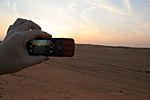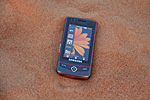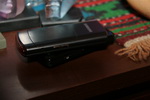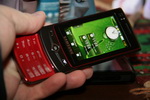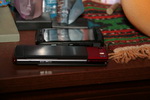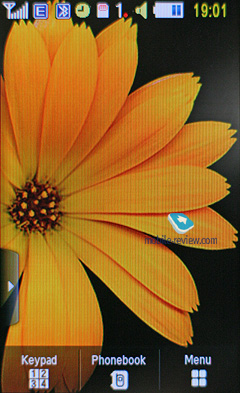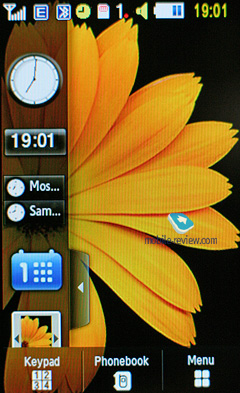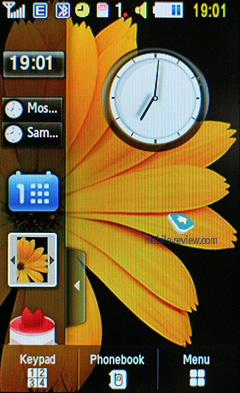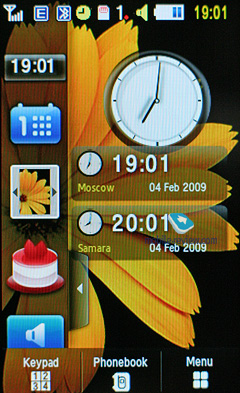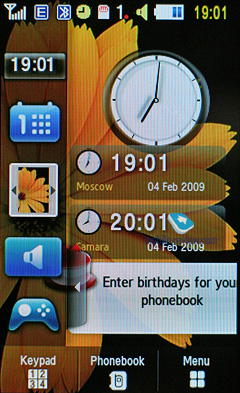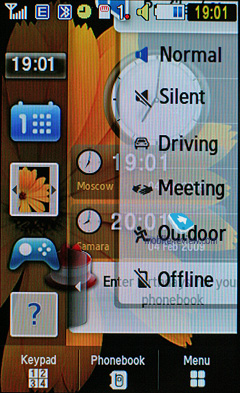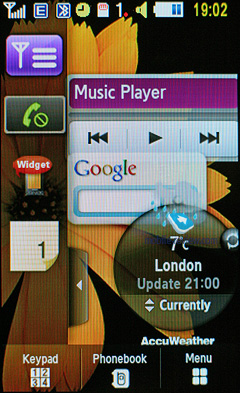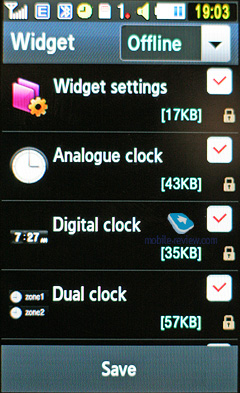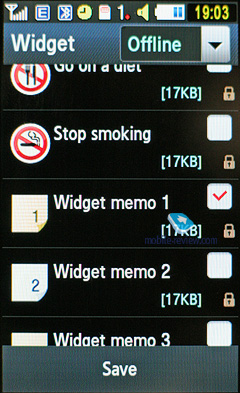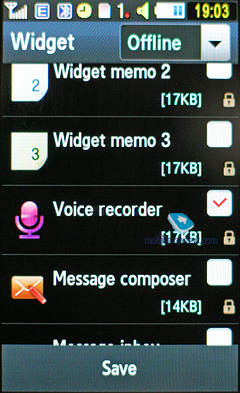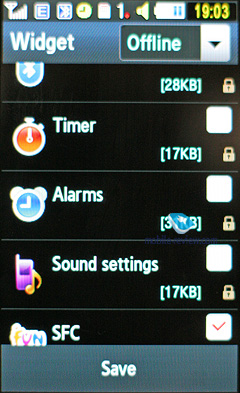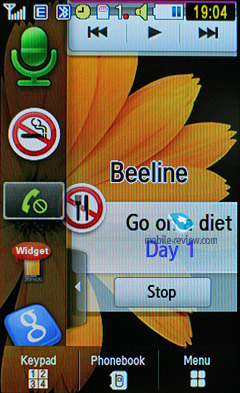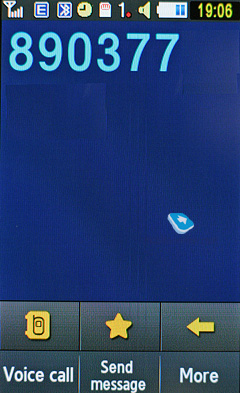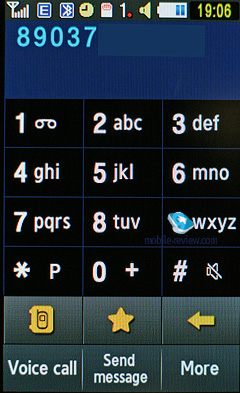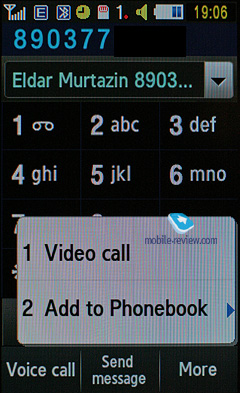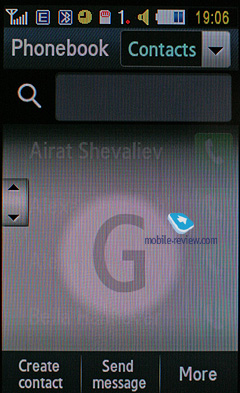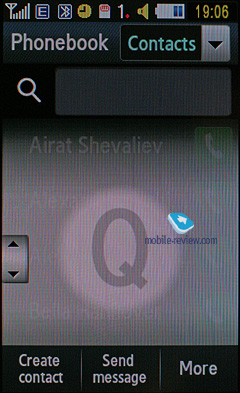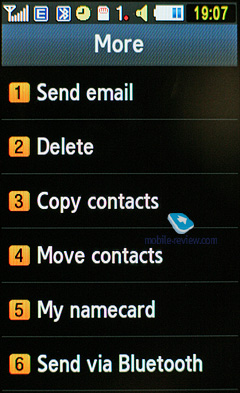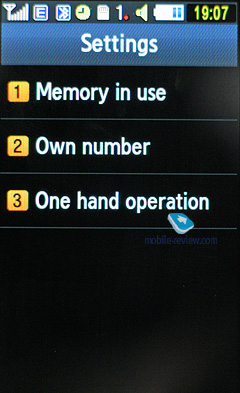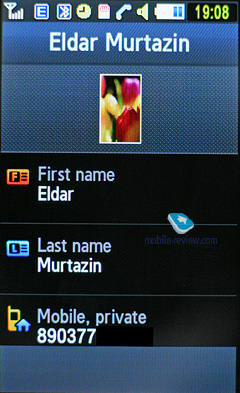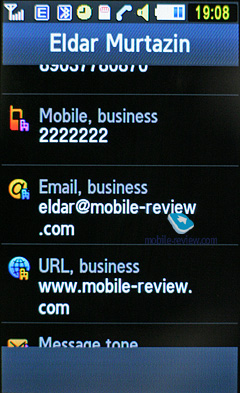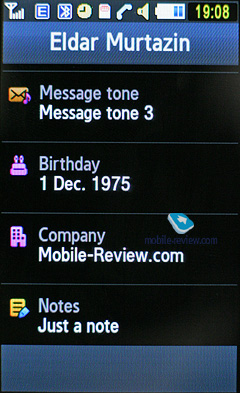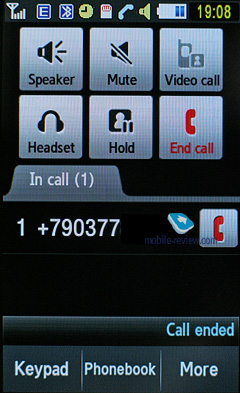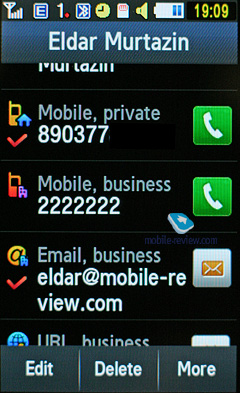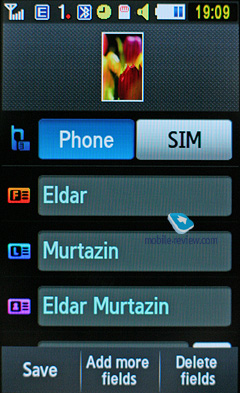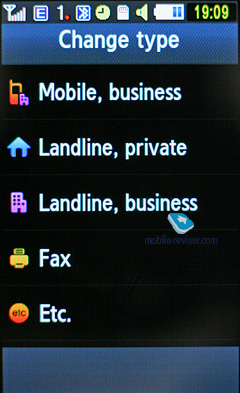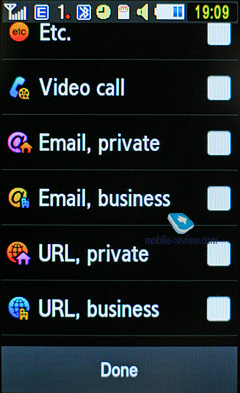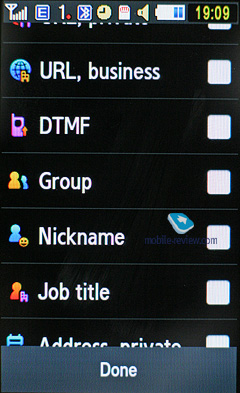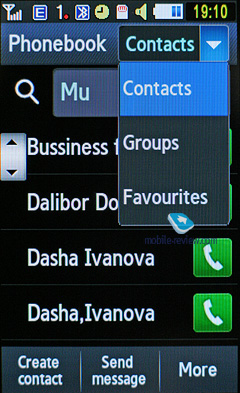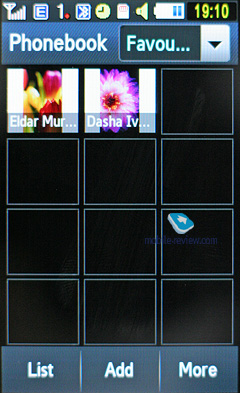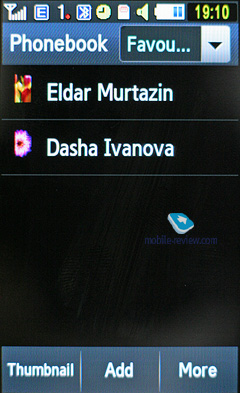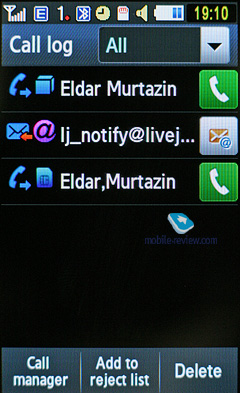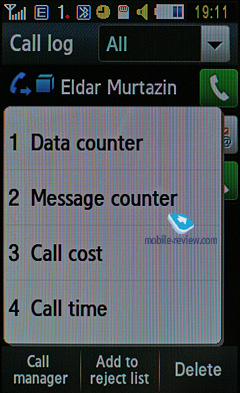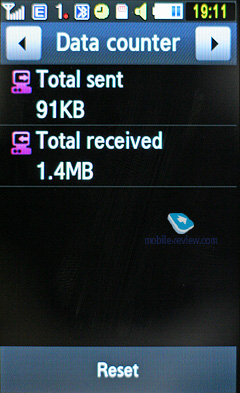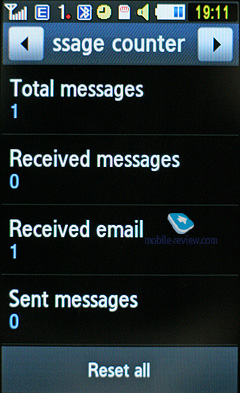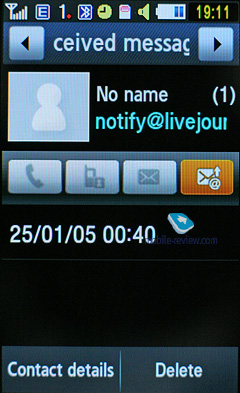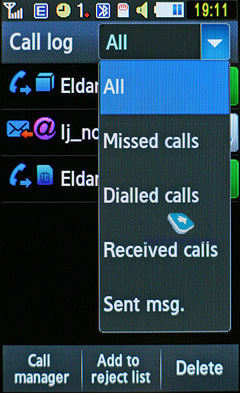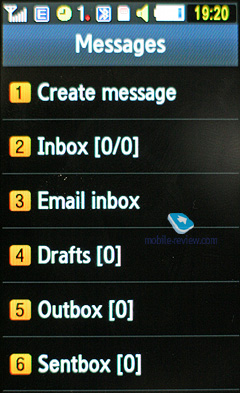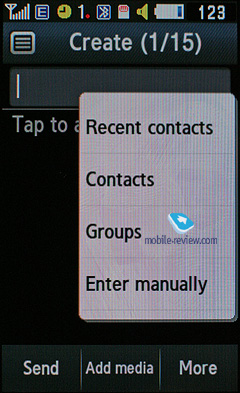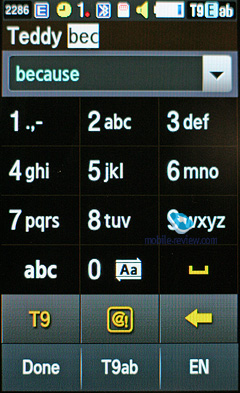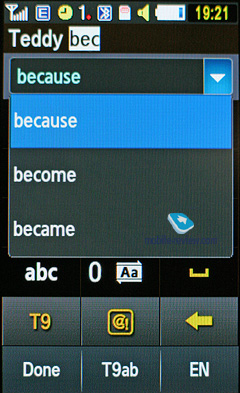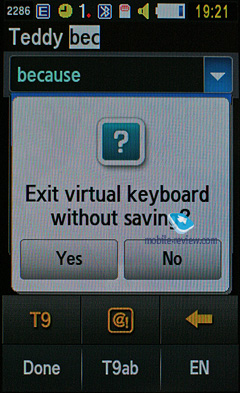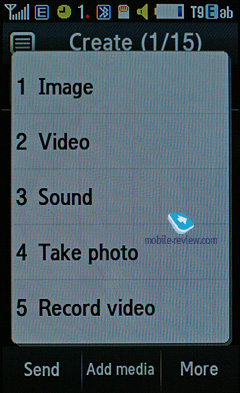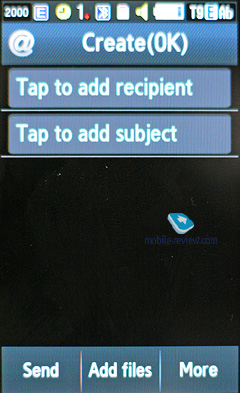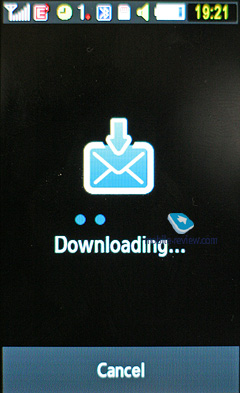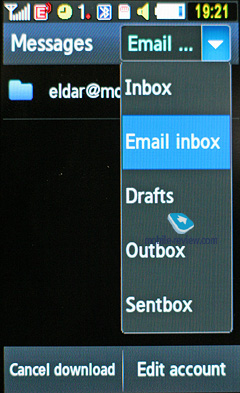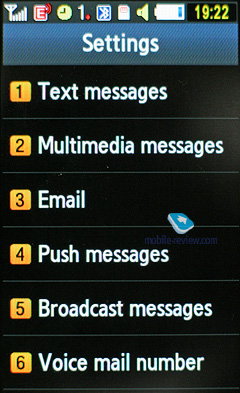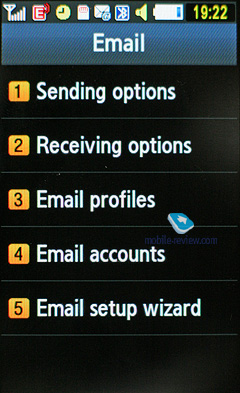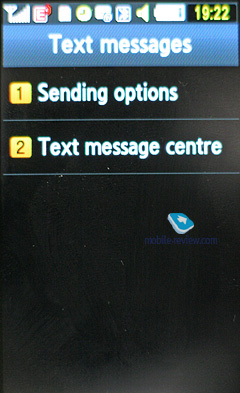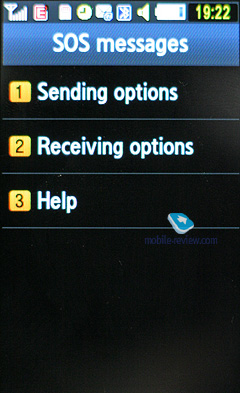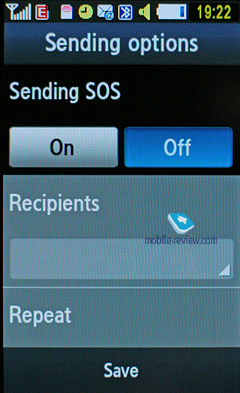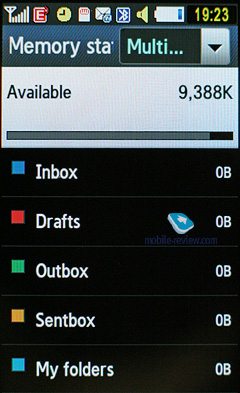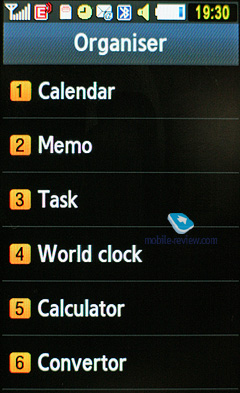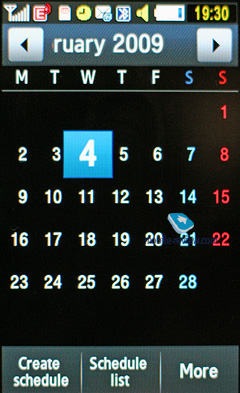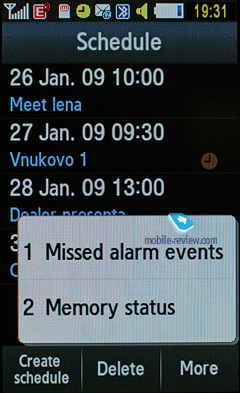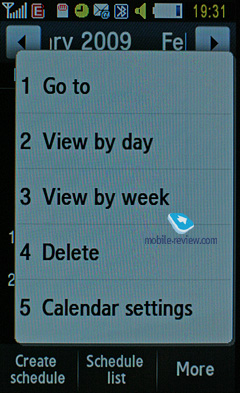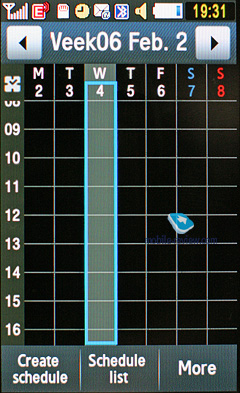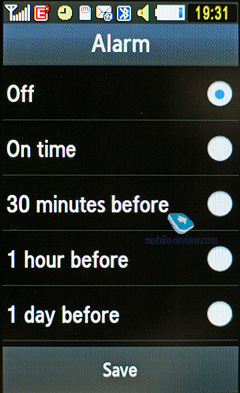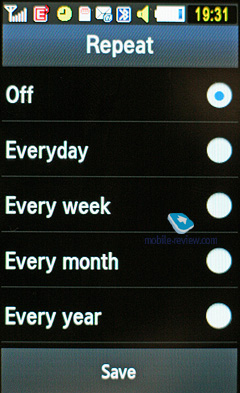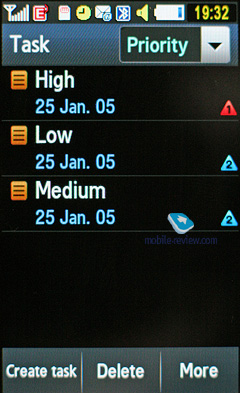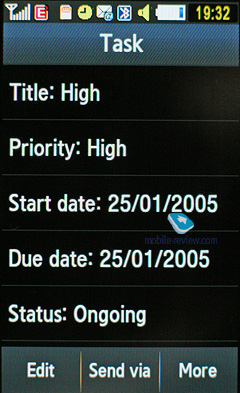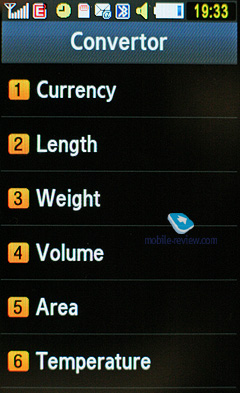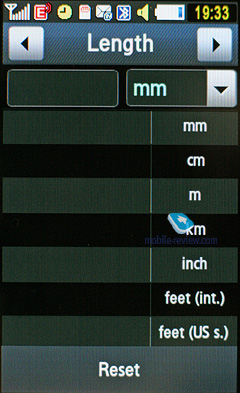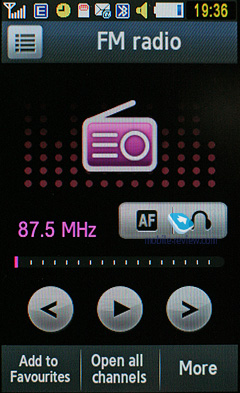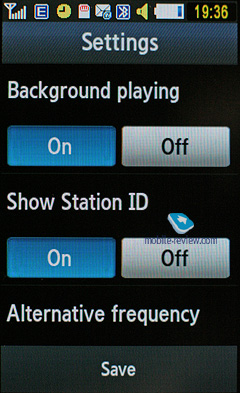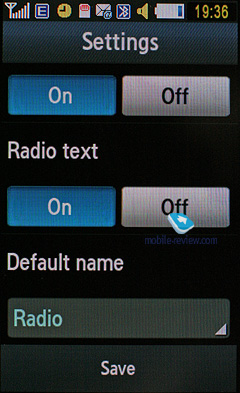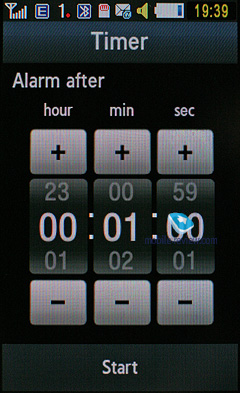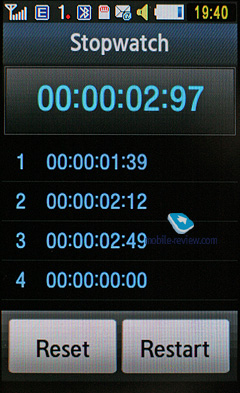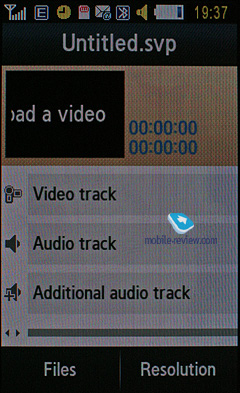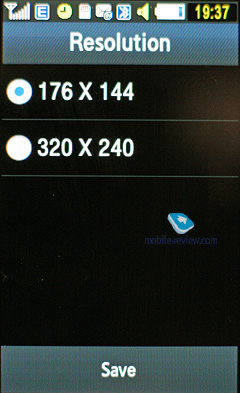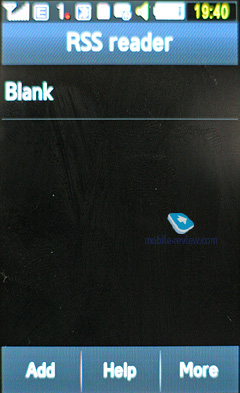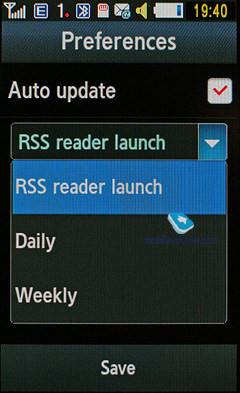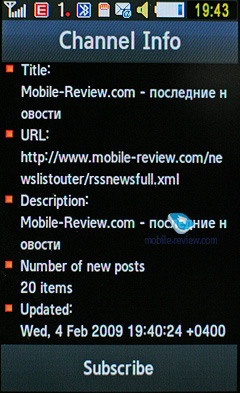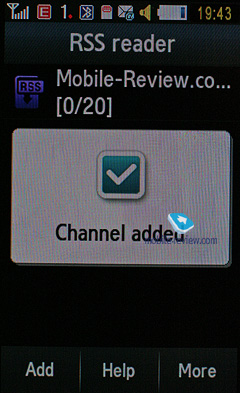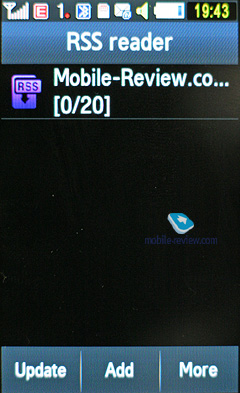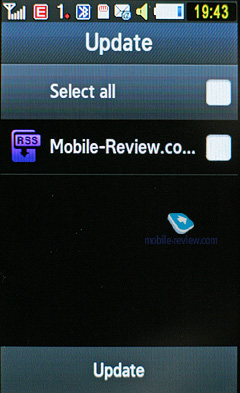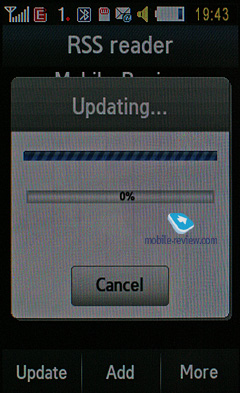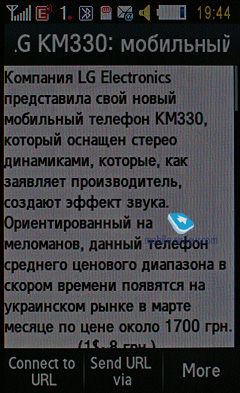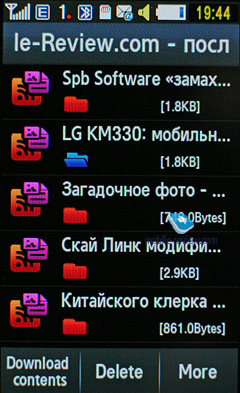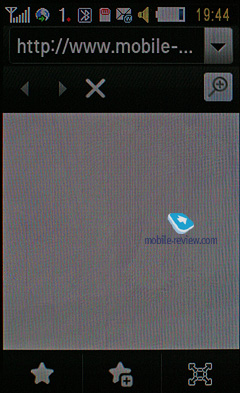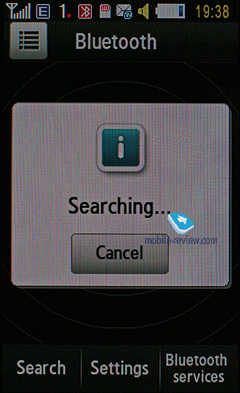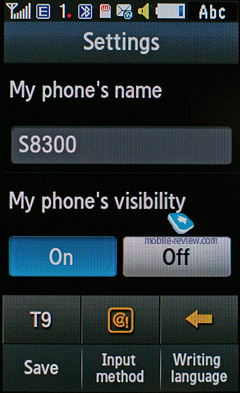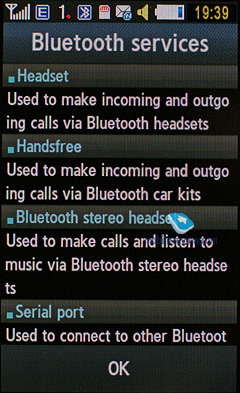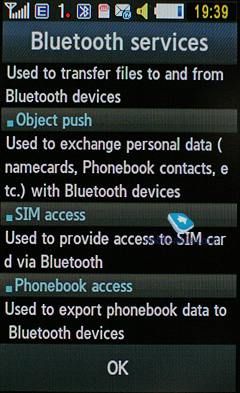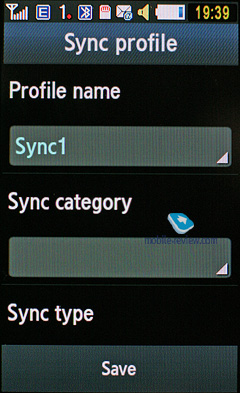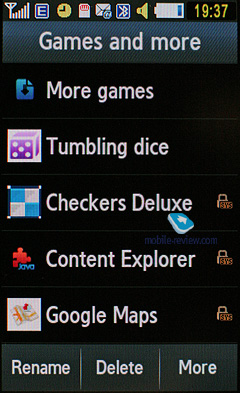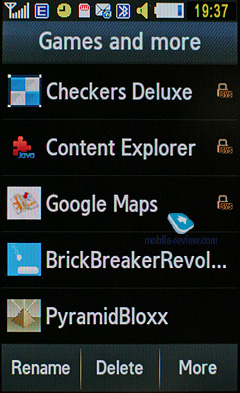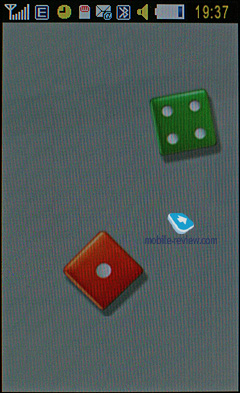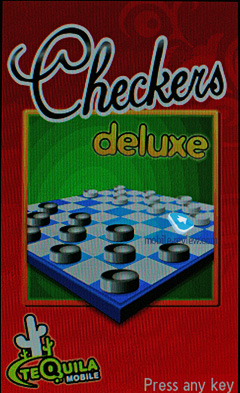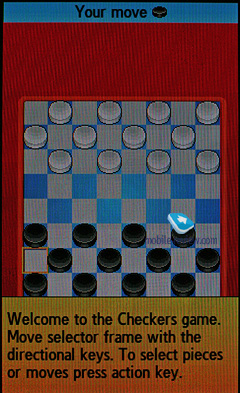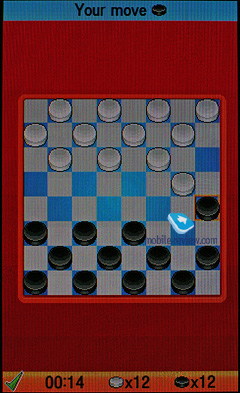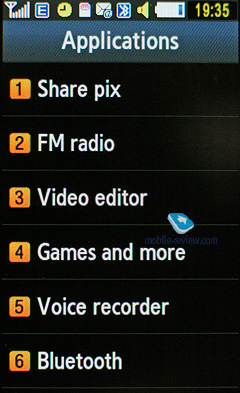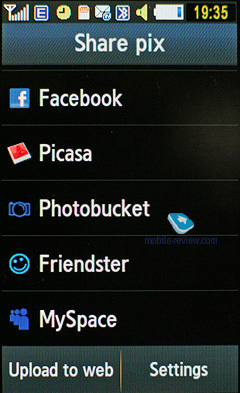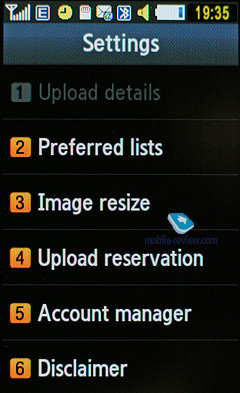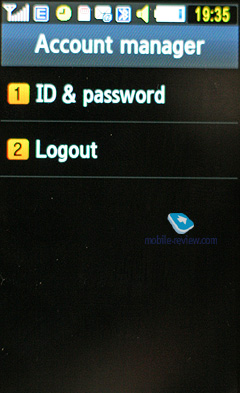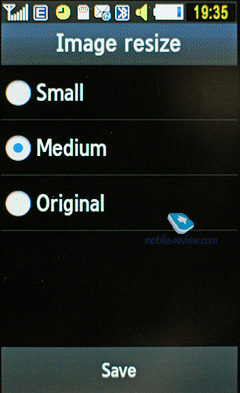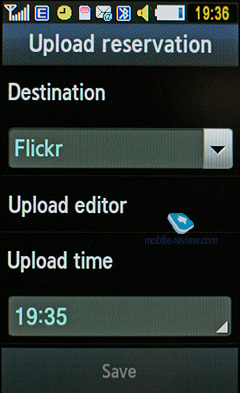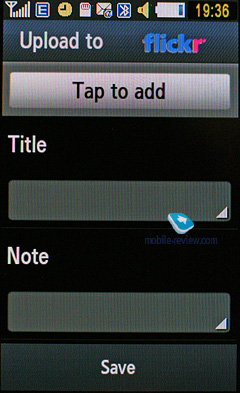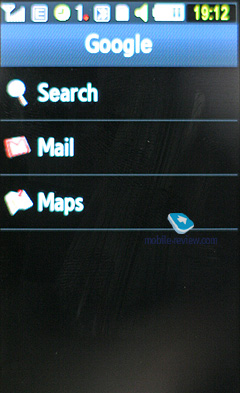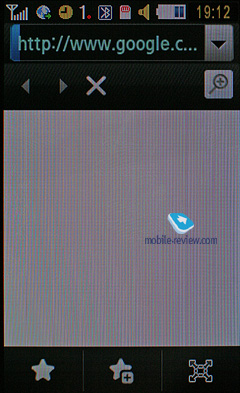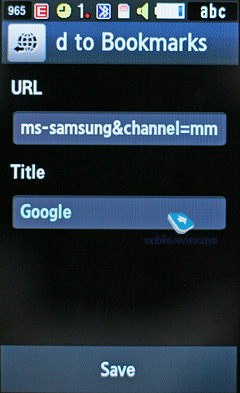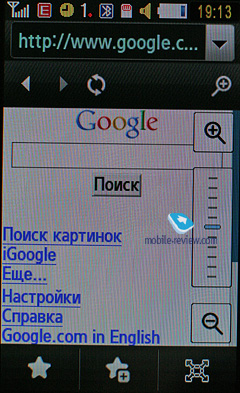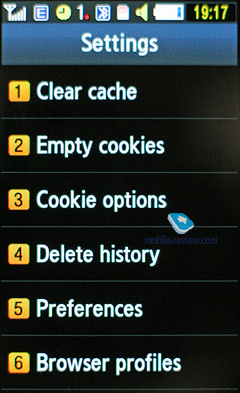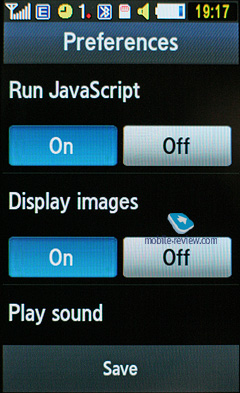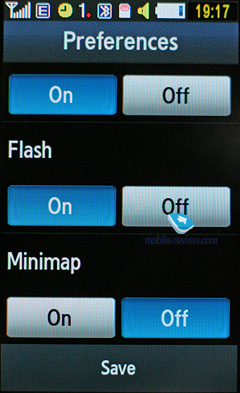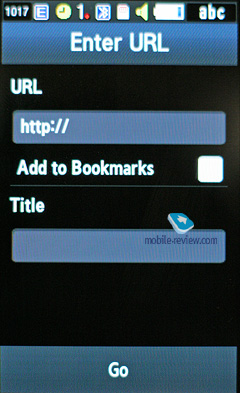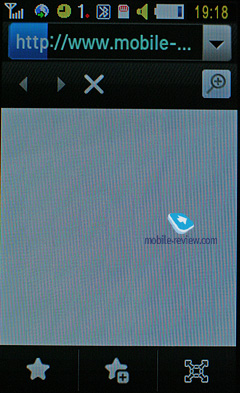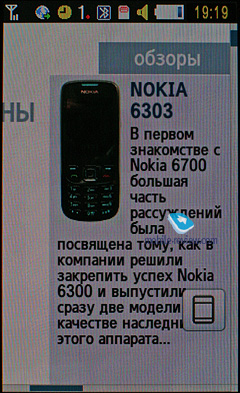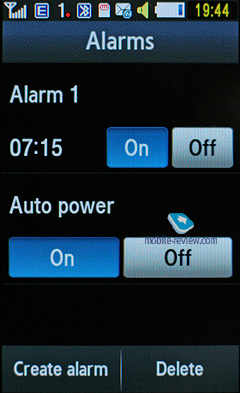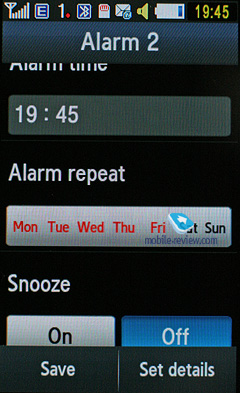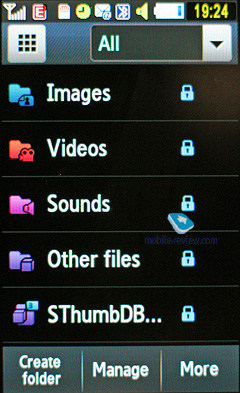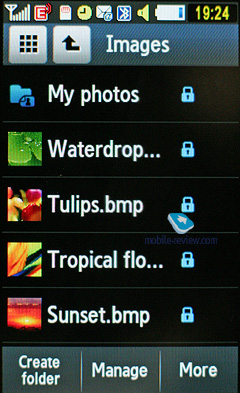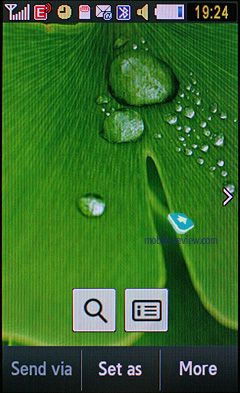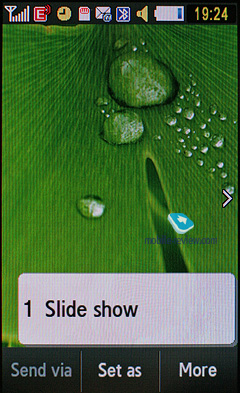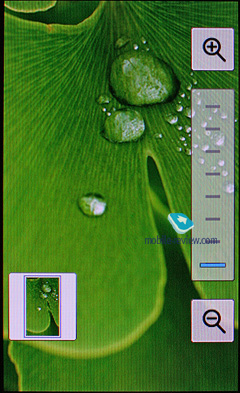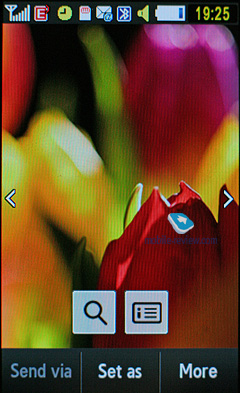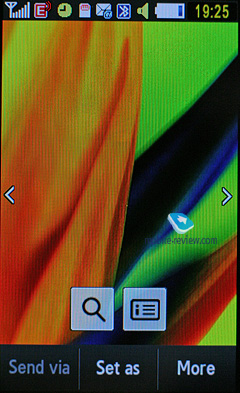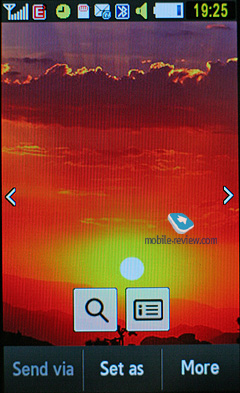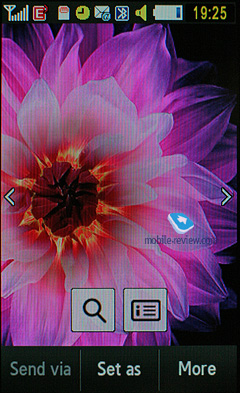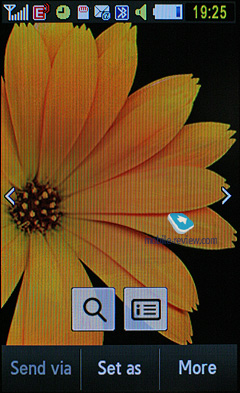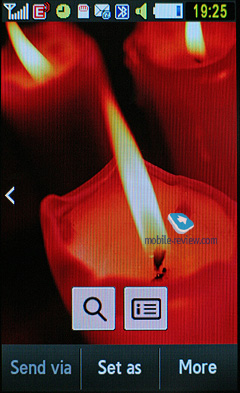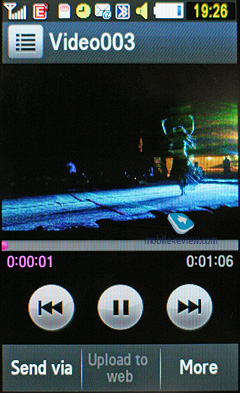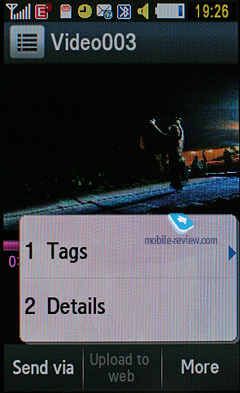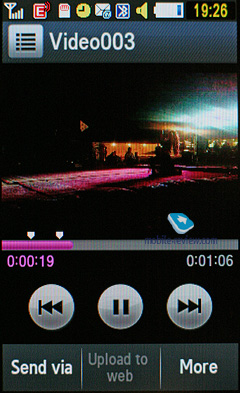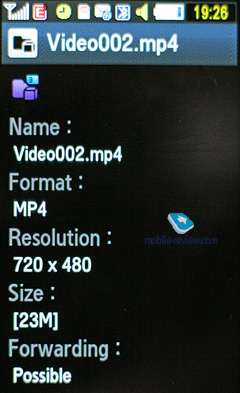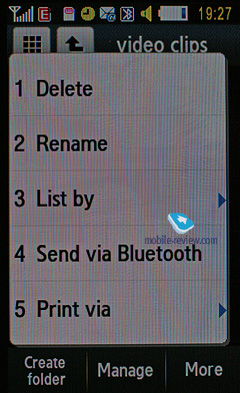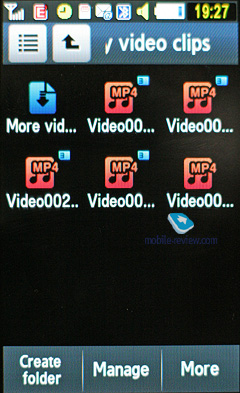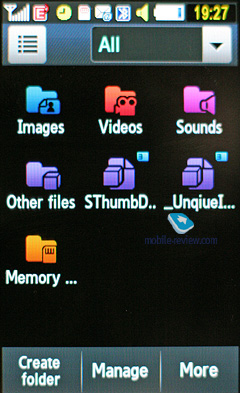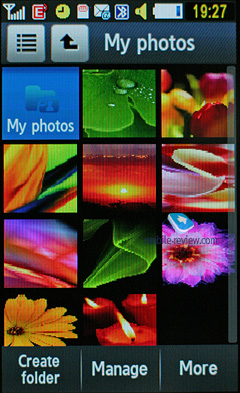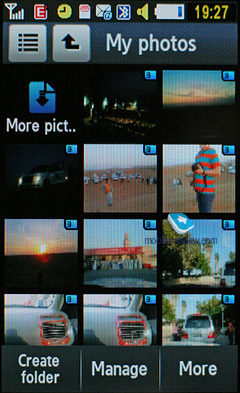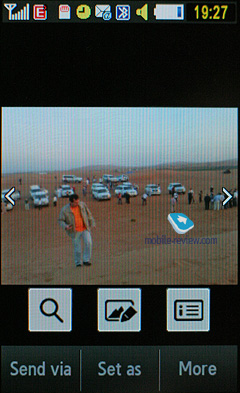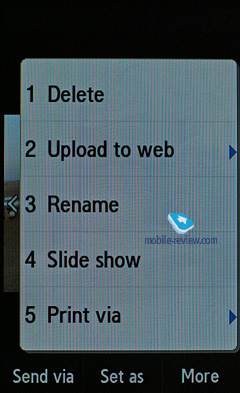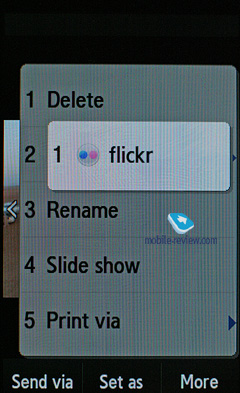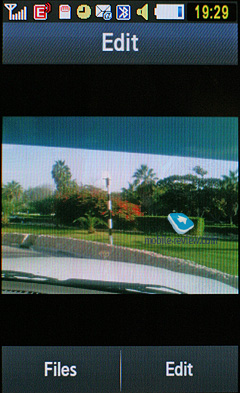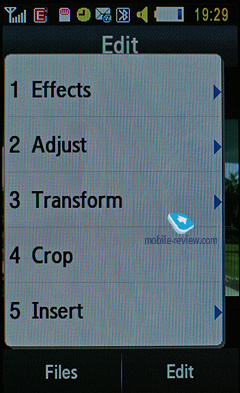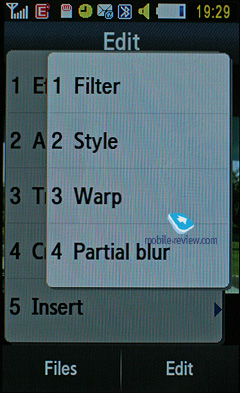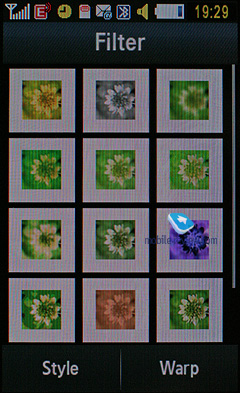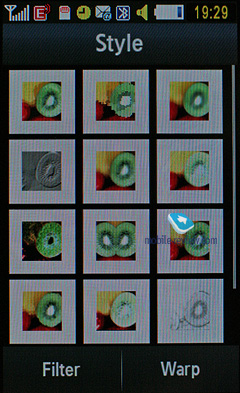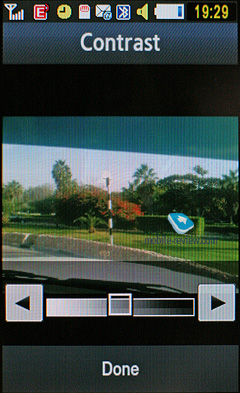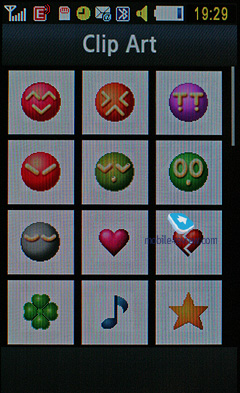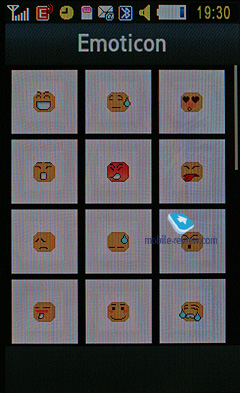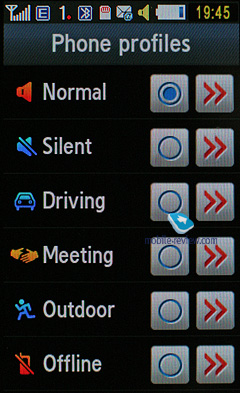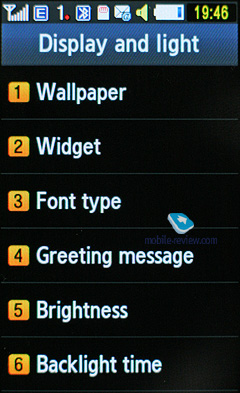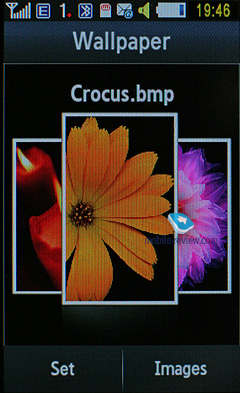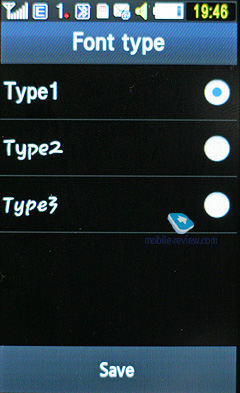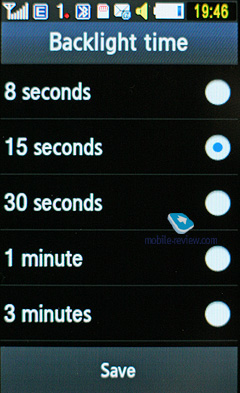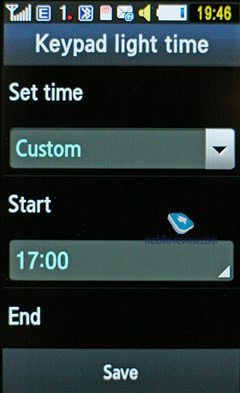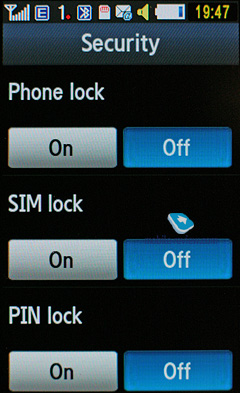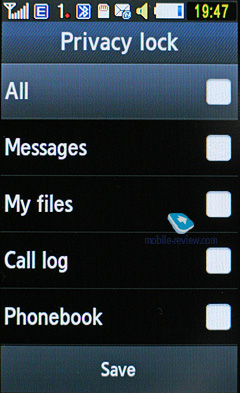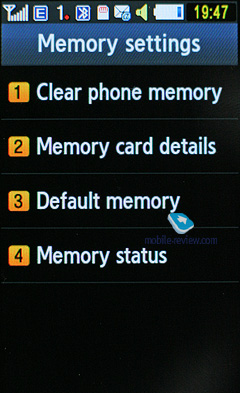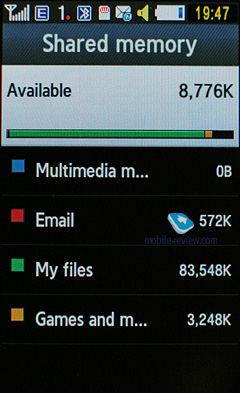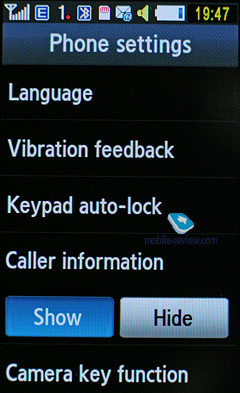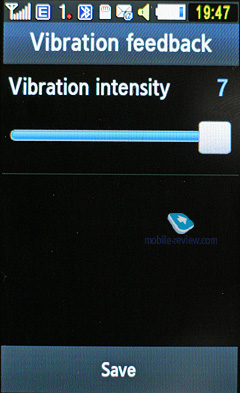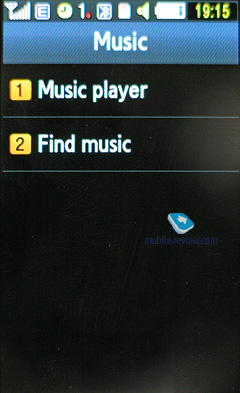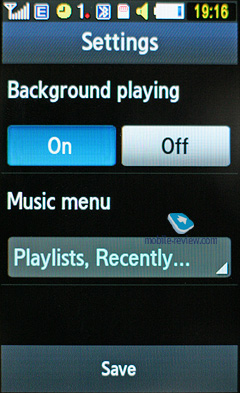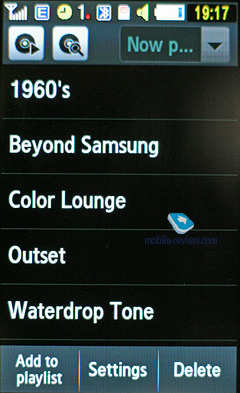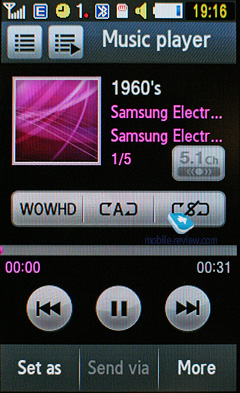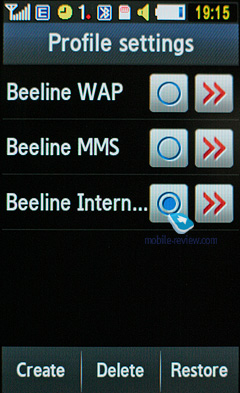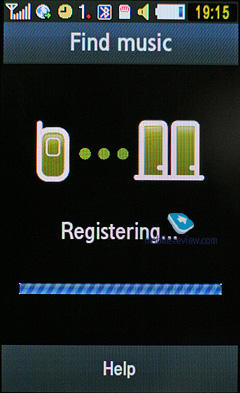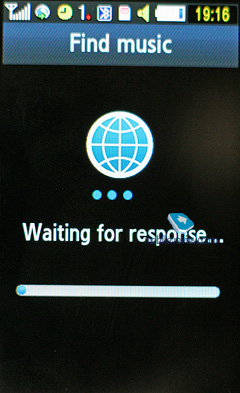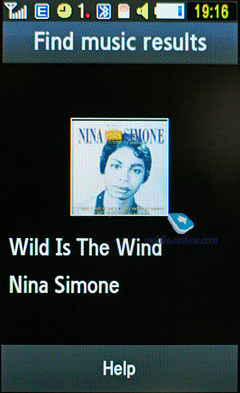|
|
Review of GSM/UMTS-handset Samsung S8300 Ultra Touch
Live images of the Samsung S8300 Ultra Touch
Table of contents:
- Positioning
- Design, Size, Controls
- Display
- Battery
- Connectivity
- Memory, Memory Cards
- Performance
- Camera
- Menu, User Interface
- Phonebook
- Call Log
- Messaging
- Organizer
- Applications
- Alarm Clock
- File Manager (My files)
- Settings
- ÌÐ3-player
- Watching video with the P8300
- Picsel Viewer
- Impressions
Sales package:
- Handset
- Li-Ion 880 mAh battery
- Charger
- USB data cable
- Wired headset (with 3.5 mm auido jack on the wire)
- microSD memory card (size varies by region - 2Gb or more)
- User Guide
- Software CD
Positioning
The Ultra series is already several generations old, and to be really precise, the Samsung S8300 represents its fourth incarnation, being Samsung’s flagship device for 2009 at that. While originally this line-up was intended to be a bunch of slim phones, later on it evolved into an elite selection of phones with state-of-the-art features. All Ultra-branded flagship solutions have always enjoyed decent sales, even the Samsung U600, whose touch-sensitive buttons were the deal-breaker to some, but the rest got attracted by its smooth design.


In fact, Samsung have never been afraid of experimenting with the functionality of their flagships, and oftentimes they went as far as breaking the continuity line, positioning new phones for different audiences, making the jump between various generations of Ultra-labeled phones not as seamless as many would’ve liked. The Samsung D900, for example, along with its updated version, the D900i, fell just short of legendary - released in autumn 2006 it got off to a good start, and the fact that even these days it’s still available in most stores indicates that it’s enjoying a really long life cycle, which isn’t particularly common among Samsung-branded phones. Furthermore, it’s one of those rare cases when my skeptical forecast for that phone never came true, as the market made its own choice.
Many owners of the D900 haven’t changed it yet, why? The reason is that the Samsung U800’s design was geared towards the younger portion of the audience, plus its touch-sensitive controls made the whole experience different. The third flagship phone in this range, the U900 Soul, housed a touchscreen instead of a standard navigation pad, which was a bit too novel and quirky for the users of the Samsung D900. So, as it turns out, they simply haven’t seen a worthy replacement for their devices yet. And if somebody thinks that it’s about time we wrote something along the lines “Samsung S8300 is the saving grace these people have been waiting for”, that’s a big mistake – in truth, the S8300 is another bold leap forward that fuses a lot of different concepts and ideas together.
It’s worth nothing that normally most people interpret the “flagship” term as a phone that sells in droves and is pretty much unmatched on all fronts. But more often than not, that’s not the case – effectively, a “flagship” is a device that’s important to its manufacturer, a “hero” as they tend to call it. So, while the phone maker may take great pride in such a solution, there is no guarantee that it’ll see any kind of decent sales. It makes much more sense to treat flagship phones as icons, specific agendas of phone makers that materialized in the form of phones – sometimes they hit the bull’s eye, like the Samsung D900, sometimes they don’t and then they roll over and die after some time. Now let’s glance over all four generations of the Ultra line-up and all flagships it has seen over these years.
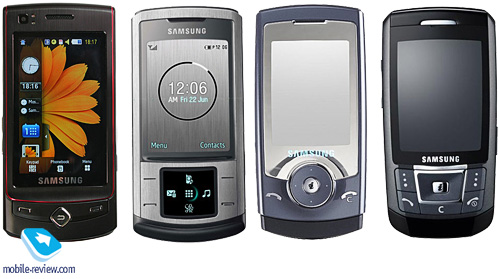
The D900 capitalized on the idea of a “slim” casing, and on top of that it was one of the first phones that came bundled with a 3 MP camera. The Samsung U600 offered a glossy and very streamlined design and no hardware controls at all, that were replaced by touchpads. All in all, it was the epitome of that time’s hottest trends, especially the craze around touch-sensitive keys, that didn’t last long, though. In its turn, the Samsung U900’s main focus was metallic accents in its casing, plus a touch-sensitive screen that acted as a navigation pad. By and large, all this time Samsung have been beefing up the feature packs of their flagship offerings to the maximum, trying to follow all latest tendencies at that. With this in mind, it doesn’t take a rocket scientist to predict their next move, seeing what feature seems to be everyone’s flame today. In case you still can’t guess, it’s the touchscreen. I’ll even go as far as saying that all Ultra-branded flagship phones mirror current market trends and consumers’ tastes. Hence the “Touch” prefix in the model’s name that has been used and re-used by so many companies, specifically Apple and HTC. One may call these solutions opportunistic, but in truth I can’t think of any other phone maker that is capable of churning out models like this one after another; and not only that, Samsung have also managed to sell all of them in great quantities. Indeed, the LG KF700, unleashed at World Mobile Congress 2008, arrived with some interesting menu themes and an unconventional positioning, acting as a rival to the Samsung U900 Soul; but eventually it didn’t work out and as soon as its advertising support was gone it literally ceased to exist. Evidently, it takes a few more things to succeed, apart from bare technology.
Samsung S8300 Touch vs Samsung U900 Soul:




Speaking of which, Samsung are very serious about how they position their solutions and as a result their phones target the right audience and meet all their requirements. So this pops the question: who the S8300 Ultra Touch targets? Before we tackle this issue, I’d like to note that this phone doesn’t have any direct rivals; even though LG will come up with a somewhat similar solution, but at the end of the day it won’t be able to pose a serious threat to Samsung (like it was the case with the LG KS6600 that was a hopeless copy of the Samsung D980 Duos).
However, lack of direct competition doesn’t necessarily mean the S8300 will have an easy life. It will appeal to those looking for the latest and most fashionable phones, 20-35 year olds, with a 50\50 men-to-women ratio. However it’s the first time when they will release a backup model that will target those who need to replace their already-dated Samsung D900/D900i. That’s why they have deviated from their usual rule of announcing all new solutions on WMC’s Day 1. The S8300 launches a week earlier in order to attract more attention and make its presence a bit more distinguishable. On February 16th, however, we will offer you a comprehensive comparison between the S8300 and its mysterious brother-in-arms, so don’t forget to check back. And until then, we won’t take the wraps off one of Samsung’s key products in 2009 that will become an incredibly popular and sought-after offering in its segment.
Back to the table of contents >>>
Design, Size, Controls
If there is one thing that doesn’t change over time, it’s the form-factor of Samsung’s flagship devices – the S8300 is no different from its predecessors, being a slider-type phone without a navigation button. When people first encounter this handset, at first they try to move around its menus via the numberpad and as soon as they come to realize it doesn’t work out too well, they timidly press the screen to see if it responds, and... it does! In my mind, the lack of a standard navigation button renders the phone's hardware controls next to useless for any task other than number dialing. On the other hand, though, it’s easy to get used to, so this setup won’t give you any trouble at all.

Video, looks, menu, user interface (wmv, 143 mb) >>>
The phone measures up at 110x51.5x12.7 mm and tips our scales at 116 grams, so the S8300 isn’t chunky at all, being slim, tall and quite good-looking, plus it readily slips into just about any pocket or purse. There won’t be many colors to choose from at start, though, as it will come only in Platinum Red and Seagrass Blue. When the S8300 is closed, it’s easy to figure out what its color scheme is by looking at the tiny display frame, plus the bottom end is finished in its main color (red or blue). Both the keypad and underside are color-keyed to the phone’s color scheme as well. A friend of mine, after playing around with it for some time, told me that Samsung's designers did a great job making the phone “smile”. At first I didn’t get it, but then I took a closer look at the S8300’s chromed lower end and realized that the combination of colors and curves somehow did resemble a smile. Frankly, I wouldn't have thought about it if I hadn’t been told – check out the video below, do you see it too?





Samsung S8300 Touch vs Sony Ericsson W910:



While the phone features a spring-loaded slide mechanism, it doesn't work as smoothly as you’d expect from a Samsung-branded device. The only easy way to zip the S8300 open is to place your finger right on the display and push it up, and apparently it won’t the phone’s screen cleaner, but the S8300 manages to disguise most smudge and grease that ends up on its front fascia pretty well. Framing the display is a thin metal strip, and that’s the only detail made of metal you’ll see here – the rest of the phone’s casing is made of plastic, which is a real disappointment, when you think of how many metallic accents there were in their previous phones. The S8300 employs wear-resistant matte plastic, the same type that the D900 and U600 used, meaning that after some quality-time with it you’ll see some scuffs on it, formed by tiny, skin-deep scratches. While they won’t be all that striking, they certainly take some points away from the phone in this department. I’d really like to believe that (provided you’re careful with it) the S8300 won’t lose its pristine conditions for at least half a year.

Housed on the left-hand side is the volume rocker along with the microphone pinhole. On the right there is the microUSB socket, where you can plug in data cables, chargers and headsets (by the way there is no 3.5 mm audio jack on the S8300). Another thing of note about it is that all Nokia’s accessories fit this phone like a glove. On top of that, also on the right is the display lock button, although it would have been much better off with a slider key for these purposes. Lastly, there is the dedicated camera button, and I don’t think you want to hear more about it.


The phone’s 8 MP camera, LED flash and self-portrait mirror are mounted on the rear side of the top half, so when it’s closed you won’t see them. Sitting above the display is the forward-facing camera for videoconferencing along with the ambient light sensor.

A few words about the S8300’s build quality – it’s pretty good, although not stellar; we’d rate it the same as other Samsung’s plasticky sliders. In other words, if you like how their other phones are built, you’ll definitely fancy the S8300 Touch as well, and if not – you probably won’t.
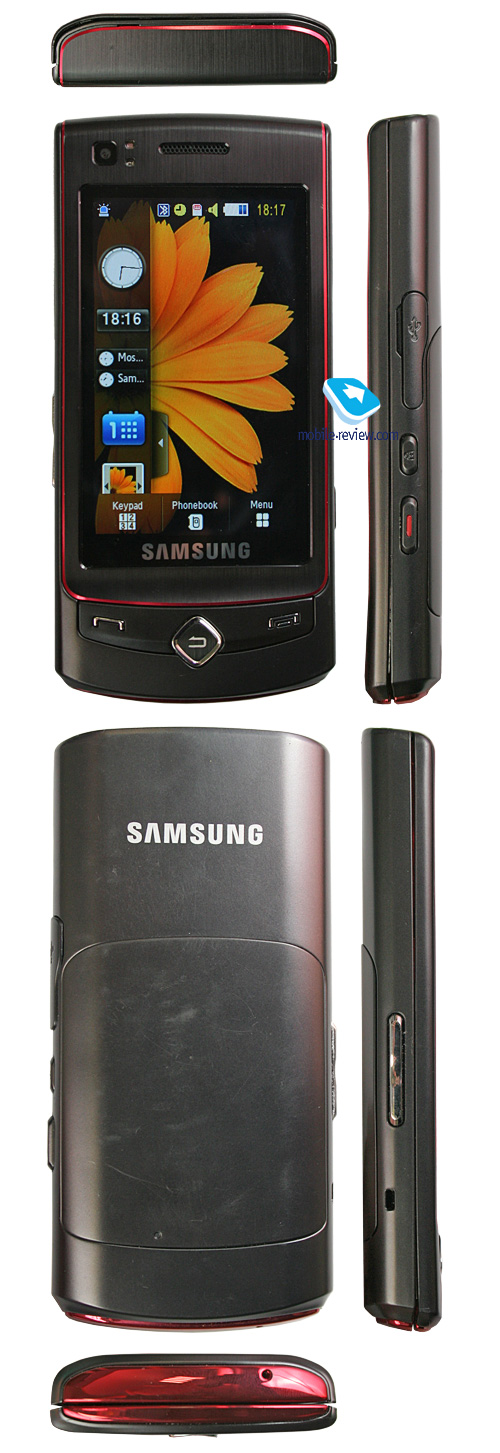
Back to the table of contents >>>
Display
The S8300 comes bundled with a 2.8 inch widescreen display, capable of 240x400 pixel resolution (36x62 mm, AMOLED) and 16 million colors. While its sibling, the Samsung M8800 Pixon, boasts a larger diagonal, its TFT matrix makes all the difference, as it can’t stand comparison to the S8300’s stellar colors and brightness level. All you need to do is put them face to face to see that the latter is a clear winner. Needless to say, this phone’s screen is one of the finest out there, and this shouldn’t come as a surprise, since Samsung owns a whole division focused solely on displays.

All data input is done via this touch-sensitive display, running the Capacitive Touch Screen technology - in other words, unlike more conventional touch-screens, it packs no sensors and rather employs a special oxide layer on top of its screen, which reacts to touches of your fingers, basically, a stylus or any other sharp object won't do here. With a pair of gloves on, you will still be able to use the S8300's hardware buttons, while typing up a short message will prove to be impossible.
Among this technology's edges is the display protection, be it plastic or glass, which provides a higher degree of safety than on standard touch-sensitive panels (the S8300 employs a plastic screen). Also with the S8300 it doesn't matter how dirty the screen's surface actually is - you will still get pretty decent reaction time and accuracy. The display itself is slightly sunk into the casing (which doesn’t affect its ergonomics), so you won’t have to worry about it getting scratched when you put it face down.
Samsung-branded offerings also employ the VibeZ feature so as to make the casing vibrate a little, confirming your actions, and we do mean "actions", since it gives you an unobtrusive buzz whenever you tap some action-related keys.
The display accommodates up to 14 text and 3 service lines, but you can cram as many as 24 lines into it when reading a message, depending on the font size you have picked. The volume rocker now lets you scroll through pages back and forth and doesn’t change font size anymore (like in the M8800). What really matters is that unlike most other offerings, the S8300 sports huge-ish font sizes, which are very readable from almost any distance.
The S8300’s display gets washed out under direct sunlight, which hurts it legibility, but it still fares better than the M8800 Pixon.
The phone also houses a motion sensor that allows the display to re-align the image whenever you turn it.
Back to the table of contents >>>
Battery
The handset utilizes a 880 mAh Li-Ion battery, rated for 300 hours of standby and 4 hours of talk time. In Moscow the S8300's battery time averaged around 2 days (a bit over one hour of calls, a couple of messages a day, very little email and up to two of radio). Those who are into mail and web, will be able to squeeze around a day of life time from the S8300. But in general, this handset can stay up and running for 1-2 days hands down. Unfortunately, there is no extra battery cover for this handset. It takes the phone around 2 hours to charge up.

Back to the table of contents >>>
Connectivity
Bluetooth. The model supports various profiles, such as Headset, Handsfree, Serial Port, Dial Up Networking, File Transfer, Object Push, Basic Printing, A2DP. EDR-enabled Bluetooth 2.1 is onboard. Wireless headsets are handled by the S8300 with ease.
USB-connection. In the menu you may select one of three modes: Media, Mass Storage, Samsung PC Studio. When connected to a PC via USB, the P8300 automatically recharges itself.
While in the USB Mass Storage mode, the S8300 shows up on the desktop without requiring you to install any additional drivers, so right after plugging in it's ready to work. Data connection speeds top out 1200 Kb/s.
You won't be able to use the S8300's Bluetooth connectivity along with USB - it will require you to disable Bluetooth regardless of its status (connected and transferring data or not), which is very awkward.
There is also EDGE class 10 connectivity for GSM networks.
Back to the table of contents >>>
Memory, Memory Cards
The phone ships with 90 Mb of onboard memory - this storage space, give or take, is available to the user right out of the box. The memory card is displayed as a separate section, but you can also view both memory card and internal storage at the same time. The S8300 also comes with a file manager, enabling you to copy files to/from the memory card. In our test the handset had no problems handling a 32 Gb microSD memory card.
The memory card slot is perched under the phone’s battery, so you will have to power it off first.
We didn't like how long it took the S8300 to copy files from the bundled storage onto a memory card - actually, it managed to move a 50 Mb file in 7 minutes or so, which is pretty slow by today's standards.
Back to the table of contents >>>
Performance
The S8300's performance will hardly blow you away - it's pretty much in one boat with other latest and greatest offerings from Samsung, although it has got some distinctive touches to it. That is, it can multitask with Java applications, meaning that apart from closing an app you can minimize it and call it back to the top later on. On the down side, however, there is no task manager to be found, so you'll have to dig through the phone's menu to bring minimized applications up (you'll see a distinctive icon next to all currently running applications). Using the phone's Connectivity settings you can set up a background Internet connection to run for Java applications, allowing you to keep an IM client and some other apps in the background (we managed to have 8 apps running at a time). The S8300 also supports 3D JSR, including all JBenchmark tests. As far as Samsung is concerned it's a huge leap forward considering how hobbled the Java machine on their previous offerings was. Also, from now on you can install new applications not only over the air but from the phone's internal storage and memory cards as well. Java apps can't exceed 1Mb in size.
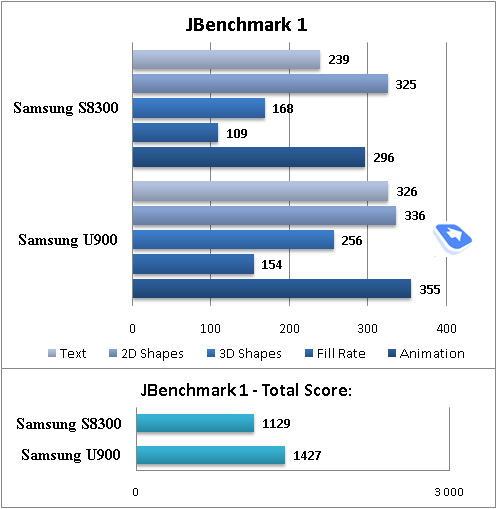
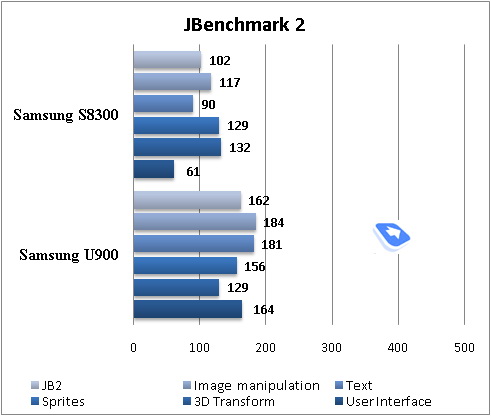
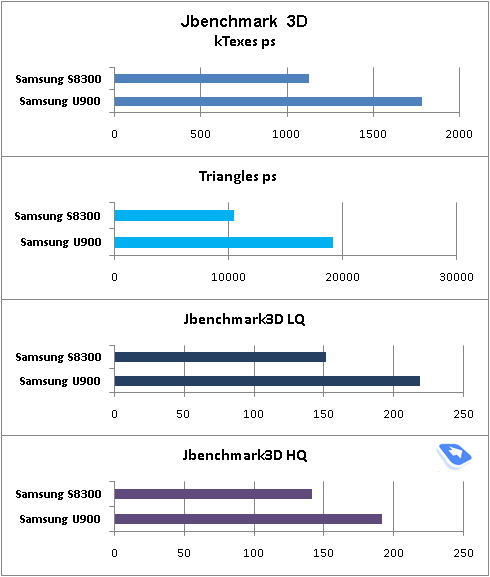
Back to the table of contents >>>
Camera
The S8300 isn't an imaging-centric solution, rather, this department is one of its primary focuses.
The S8300 camera’s specs are as follows:
- 8 Mpix CMOS module, 1/3.2 inches
- x4 digital zoom (no optical zoom, regrettably)
- LED flash
- Miminun macro distance – 10 cm
- Face Detection/Smile modes
- ISO – 100, 200, 400,800, 1600
- F=2.6 mm
The S8300 enjoys a landscape camera interface and allows the user to tweak all settings and change options on the fly by simply tapping on thumbnails you need right on the screen. Needless to say, this makes the phone’s camera app a breeze to work with.
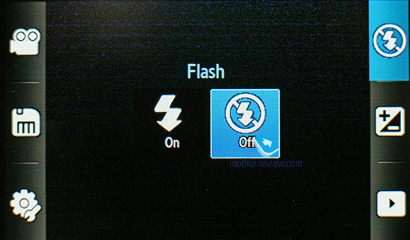
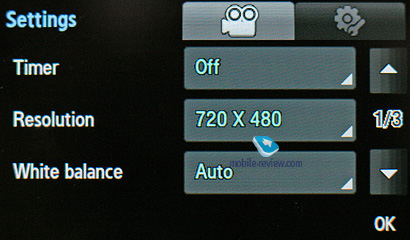

The phone also comes equipped with a GPS receiver that, however, keeps a low profile in all menus except for the camera app, where it enables geo-tagging.
We’ll talk more about Face Link mode when we get to the S8300’s Photo Browser. The last thing we need to note between going straight to the camera’s settings is that the handset comes bundled with an image stabilizer (when using it you won’t be able to adjust ISO level).
Resolutions:
- 3264x2448
- 2560x1920
- 2048x1536
- 1600x1200
- 640x480
- 3264õ1960 (wide)
- 20481232 (wide)
- 400x240 (wide)
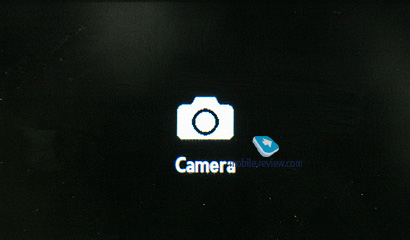
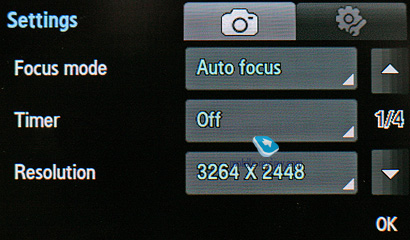
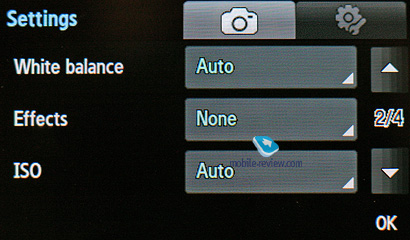
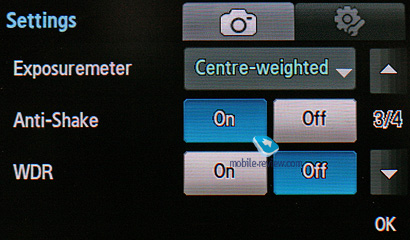
Shooting modes:
- Single shot
- Multi-shot
- Frame shot
- Mosaic shot
- Panorama shot
- Smile shot
Scenes:
- Portrait
- Landscape
- Sports
- Indoor
- Beach
- Sunset
- Dawn
- Waves and snow
- Night shot
- Against light
- Fireworks
- Text
White balance:
- Auto
- Daylight
- Incandescent
- Fluorescent
- Cloudy
Effects:
- Black and white
- Sepia
- Negative
- Watercolour
- Emboss
- Outline
Also there the S8300 features macro mode onboard.
Using the settings menu you can select a special mode for shooting text fragments, although you probably will never have to turn it on, since even in the Auto mode the S8300 does a great job adjust all options and settings for crystal clear snaps.

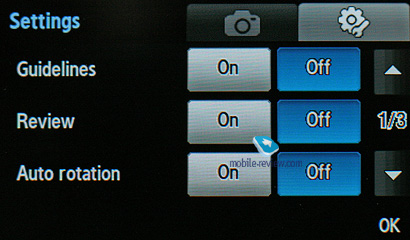
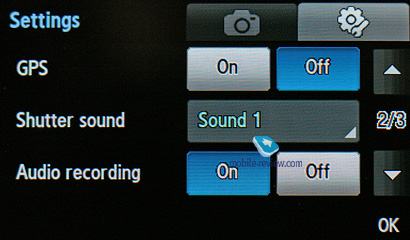
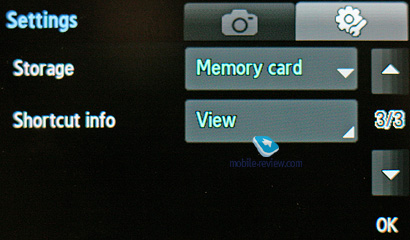
Sample images:
 |
 |
| (+) enlarge, 3264x2448, JPEG |
(+) enlarge, 3264x2448, JPEG |
 |
 |
| (+) enlarge, 3264x2448, JPEG |
(+) enlarge, 3264x2448, JPEG |
 |
 |
| (+) enlarge, 3264x2448, JPEG |
(+) enlarge, 3264x2448, JPEG |
 |
 |
| (+) enlarge, 3264x2448, JPEG |
(+) enlarge, 3264x2448, JPEG |
 |
 |
| (+) enlarge, 3264x2448, JPEG |
(+) enlarge, 3264x2448, JPEG |
 |
 |
| (+) enlarge, 3264x2448, JPEG |
(+) enlarge, 3264x2448, JPEG |
 |
 |
| (+) enlarge, 3264x2448, JPEG |
(+) enlarge, 3264x2448, JPEG |
 |
 |
| (+) enlarge, 3264x2448, JPEG |
(+) enlarge, 3264x2448, JPEG |
 |
 |
| (+) enlarge, 3264x2448, JPEG |
(+) enlarge, 3264x2448, JPEG |
 |
 |
| (+) enlarge, 3264x2448, JPEG |
(+) enlarge, 3264x2448, JPEG |
 |
 |
| (+) enlarge, 3264x2448, JPEG |
(+) enlarge, 3264x2448, JPEG |
 |
 |
| (+) enlarge, 3264x2448, JPEG |
(+) enlarge, 3264x2448, JPEG |
 |
 |
| (+) enlarge, 3264x2448, JPEG |
(+) enlarge, 3264x2448, JPEG |
 |
 |
| (+) enlarge, 3264x2448, JPEG |
(+) enlarge, 3264x2448, JPEG |
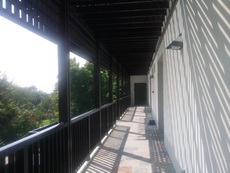 |
 |
| (+) enlarge, 3264x2448, JPEG |
(+) enlarge, 3264x2448, JPEG |
 |
 |
| (+) enlarge, 3264x2448, JPEG |
(+) enlarge, 3264x2448, JPEG |
 |
 |
| (+) enlarge, 3264x2448, JPEG |
(+) enlarge, 3264x2448, JPEG |
 |
 |
| (+) enlarge, 3264x2448, JPEG |
(+) enlarge, 3264x2448, JPEG |
 |
 |
| (+) enlarge, 3264x2448, JPEG |
(+) enlarge, 3264x2448, JPEG |
 |
 |
| (+) enlarge, 3264x2448, JPEG |
(+) enlarge, 3264x2448, JPEG |
 |
 |
| (+) enlarge, 3264x2448, JPEG |
(+) enlarge, 3264x2448, JPEG |
 |
 |
| (+) enlarge, 3264x2448, JPEG |
(+) enlarge, 3264x2448, JPEG |
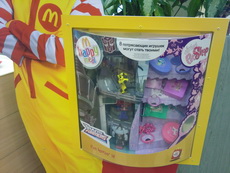 |
 |
| (+) enlarge, 3264x2448, JPEG |
(+) enlarge, 3264x2448, JPEG |
ISO
The top ISO level available in the S8300 is 1600, although it's not exactly clear why would a mobile phone need such a high sensitivity level. When shooting in fairly good lighting conditions, noises become discernible with ISO settings 400 and above. Naturally, when shooting in low light they surface much earlier. Should you decide to run with the ISO 1600, you'll get a totally blurred image with all details smeared away. Probably the only situation when you might want to use it is when you need to take a picture of some object in the dark and image quality doesn't really matter, as you just need to make sure that the object's outlines are well-visible
Panorama mode
The S8300's panorama mode is quite remarkable not only because of its image resolution, but also the way you take panorama shots with it. Basically, all you need to do is snap the first image in the sequence and then start moving the camera left or right - the i8510 will trigger the shutter automatically for the second and third images, and then it will stitch all images together. While it's pretty convenient to have the software do all the work for you, you won't be able to enjoy the quality just as much due to the abovementioned resolution limit.

(+) enlarge
Video
You can record video clips in one of the following resolutions: 720x480 pixels (30 FPS), VGA (30 FPS), QVGA (120 FPS). When capturing videos you can zoom in/out and also apply one of the standard special effects. We were more than satisfied with the S8300's quality on this front and didn’t really find anything to pick on.

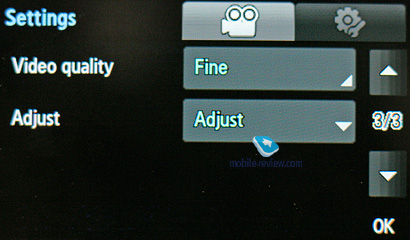
Roundup on the S8300’s camera
Given the size of the S8300, it’d be unreasonable to expect its 8 MP camera to perform as well as some imaging-centric solutions. However when it comes to shooting video, it’s little to no different from the PIXON. All in all, it’s a pretty decent choice for everyday use, if you are ready to close your eyes to the S8300 Touch’s mega-pixel count and other fancy numbers.
Photo Browser. This application is a welcome addition to the S8300’s software department – as its name suggests, “Photo browser” kicks in whenever you feel like viewing your gallery. It allows using various filters when browsing your images, such as file name or prevailing color (other filters like folder name, face tag and date are also available). By the way, the face tag feature is something we haven’t seen on mobile phones yet. Here is how it works – when browsing the gallery, select the Face Link option – the phone will try to find a face in the image you are currently browsing and in case it fails, you’ll get to select it manually and add a tag or assign the fragment you selected to a contact in the phonebook right away.
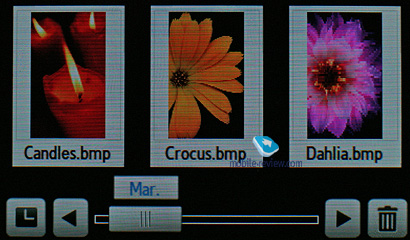
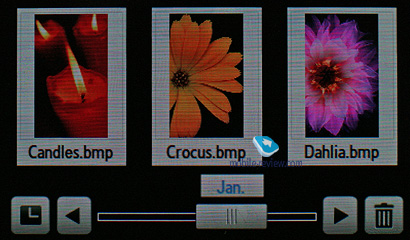
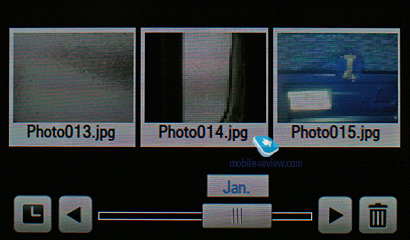
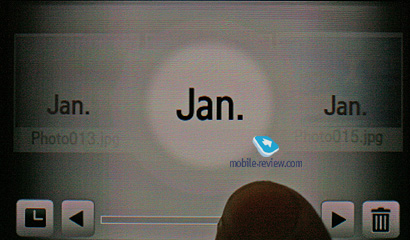

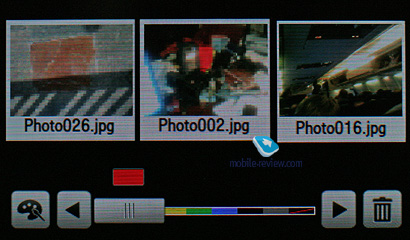
Among all other things the Photo Browser also features slide-show mode. But what we really liked about this application is that it allows scrolling through images not only with finger gestures, but also by simply tilting the phone right or left, and the lower one of the ends goes, the faster it jumps between photos, which is an interesting way to utilize the bundled motion sensor.







Back to the table of contents >>>
Menu, User Interface
In many ways the S8300’s menu and functionality are similar to the Samsung M8800 Pixon, although there are several subtle differences. While at the standby screen, the display’s base is occupied by a bar containing three shortcuts to the dialing screen, phonebook and menu. On the left is an arrow, tapping which will expand the applications bar, allowing you to drag any Widgets to the screen (their layout is also adjustable). Obviously, the S8300 looks so much nicer with only a handful of windows tacked on, rather than a cacophony of widgets all around its real estate. Let’s take a look at what things you can be up on the screen:
- Carrier name
- Date and time
- Analog clock
- Digital clock
- World time (for any chosen city)
- Player controls
- Radio controls
- Album with thumbnails (you can also scroll through images with it)
- Games shortcut
- Events (missed calls, SMS)
- Birthday reminder
- Profile switcher
- Five favorite contacts – you can call them or send SMS, all in one touch
- Mirror – uses the forward-facing camera to show what’s going on right on the screen
- Google search
- Quick access to Samsung’s Fun Club
- Alarm Clocks
- AccuWeather forecast – somewhat similar to the visual effects found in HTC’s Touch Diamond
- Stop Smoking – counts how many days you haven’t smoked
- Stop diet – counts how many days you’ve been on a diet
- Widget uploader
It’s easy to see that Samsung’s Widgets allow the user to tune and tailor the display’s layout to his/her own liking. Unfortunately, sooner or later you will run into the only real limitation of the S8300 in this department – physical size of the screen; naturally, we’d like to be able to cram more elements into it. But, it is what it is today, even in this state Widgets is the most flexible solution out there and it’s definitely ahead of Nokia’s Active Standby.
The S8300 boasts almost twenty widgets, along with a download manager that enables the user to upload new ones from Samsung’s web site. Needless to say that no other phone maker can offer anything even remotely as flexible as the S8300’s standby screen.
You can enter the main menu by pressing the icon at the bottomof the screen. The main menu is displayed as a 3x4 grid. The touch-sensitive display is easy to handle – you tap the item you need, then bring up a data input field by double-pressing it, since the first one will select it, and the next one will enabled the on-screen keypad. If the phone is slid open, the user is offered to used the hardware buttons, otherwise the only way to go is the S8300's on-screen keypad.
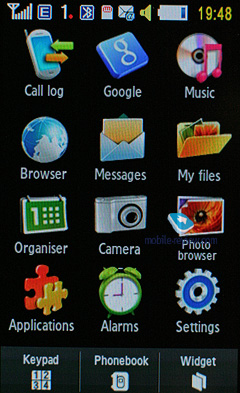
All texting is done via the on-screen keyboard, which is almost identical to that of conventional looking handsets – it houses twelve buttons with a batch of symbols attached to each, so in order to type some particular letter you will need to tap one of these buttons sequentially. While the Samsung M8800 Pixon sported a virtual thumbboard on top of that, the S8300’s smaller display made it awkward to use, so they opted to remove it from the standard package.
Another thing that has gone through a major revamp is the predictive input system T9. You can enable it both for the numberpad in one touch. The good thing about the S8300 is that it tries to predict what letters or words you will punch in next and therefore makes it a lot easier to pick word endings by simply tapping on them.
All applications feature a context-sensitive tool bar at the foot of the screen.
Another area where the S8300 improves over its predecessors is scrolling – sliding your finger down on the left will make lists scroll through much faster than if you were doing that on the right. In case the list you are browsing features names, you can always opt to jump straight to some particular letter, like in the gallery.
Back to the table of contents>>>
Phonebook
You can call up the phonebook by tapping the shortcut at the standby screen; you will see a list that contains all entries from both the SIM-card and phone’s memory. On the left there is a magnifier-shaped shortcut that allows scrolling all the way down to the letter you need. The drop-down list in the top right corner allows sorting the list by entry types – contacts, groups or favorites.
The only view available for the phonebook is a plain list with contact names – you won’t be able to browse assigned images or phone number right there, to do that you will have to enter the detailed view.
You can assign any image, photo or video clips as caller ID. Each entry can have up to 5 phone numbers of different types (mobile, office, home, fax, and other), one of them will be the main number (by default it is the first one you entered). All fields are customizable.
There are two lines for First Name and Last Name (search is performed only by the former), these fields get merged when displayed in the general list, and First Name comes first. For example Eldar Murtazin will be shown only in this order. The length of each field is 20 characters for any supported input language. You can also switch languages on the fly when entering a name.
All entries, regardless of language, are sorted out in the following way – all contacts with headings made in a local language (Russian, for example) go first and then those with names in English. This is a rather convenient and handy list sorting system. Taking into account fast language switch option during the search, it’s clear that no language will spoil the experience of working with this phone. The list can be sorted by first or last name.
But let us return to the information entered for a contact. Apart from phone numbers, e-mail address (there may be several of them), a little text memo can be submitted on top of all that. Any music file (including MP3) can be picked as a ring tone for a contact. Three caller groups are provided by default with the possibility for creating any number of additional groups, setting a personal melody and image for each (by default there are three groups). SMS alerts are not customizable.
The phonebook is capable of holding up to 2000 contacts with filled in data fields. Even if all the available blanks are not used, the cap won’t get any bigger and will still make two thousands. It is possible to specify in the settings where all new numbers should be kept by default. There is also an option for moving entries from the SIM-card, although the reverse action is denied. According to the developers, PC (MS Outlook in particular) is best for data synchronization with the S8300. Any contact in the form of SMS/MMS, mail message or other text file can be quickly sent through Bluetooth to another device. There are no problems with sending, and the phonebook entry gets beamed to another device, where it is read without any trouble.
The phonebook may contain a business card as well, though its structure copies all the fields found in a regular contact in the phone book.
There can be up to twelve numbers in the fast dial list; separate numbers tied up with a single contact may appear on this list as well.
You can create any number of caller groups, assign up to 20 contacts and customize them with a picture and tune.
On an incoming call, the caller ID picture occupies half of the screen, but that doesn’t make indiscernible.
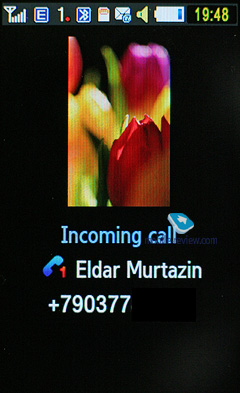
Back to the table of contents>>>
Call Log
Each of the given lists contain up to 30 phone numbers. There is a combined list of all the last calls with an icon indicating call type. You can quickly switch between the lists. The date and time of the calls are displayed in the extended view for separate entries. Calls from/to one number are grouped up, so that the number standing next to the call specifies total number of calls made. As always, the overall time of the calls and their cost can be viewed in this menu (in the case that the service has been enabled).
For certain numbers you can arrange a black list that will reject all calls coming from these contacts.
Also there is a separate list for sent messages.
Back to the table of contents>>>
Messaging
Much like other makers, over at Samsung they have forgone that artificial division into SMS-MMS types – you just start composing a message, and only then, depending on the contents, it is attributed to SMS or MMS. The menu still holds an option for switching message into MMS mode (for example when you need to send only text, but to an e-mail address, without calling up the bundled client).
The phone memory can hold up to as many as 500 messages; the handset supports EMS standard compatible with Nokia Smart Messaging. While choosing recipient, you can either select a telephone number from your contacts, or pick one from the call lists or groups. All messages are manageable, this means you are at liberty to move a certain number to your black list, in order to make sure all messages coming from that phone number will be deleted automatically; possibility for moving messages to any folder of your own is also at your disposal. For e-mail, you can move not only addresses to the blacklist, but unwanted subjects as well.
There are no size restrictions as far as received messages go, though an outgoing message’s size is limited to 295 KB. As for additional services available with the S8300, message rejection and message retrieval type options are onboard. All messages are stored in general dynamic memory, the same goes for e-mails.
Also there is a useful function for sending SOS-messages – when activated, should you find yourself in an emergency, after pressing the volume key four times, the message «I am in emergency. Please help me» will be sent to contacts submitted earlier, all incoming calls from these numbers upon sending the emergency message will be picked up automatically. Recipients (not more than 5), as well as the number of Repeats may be set up manually, while the text of the SOS-message is not customizable.
The bundled mail client is standard in all its components – 5 accounts and the maximum of 100 incoming messages; attachments are also handled by the phone, though there are also several caps – there’s no way you can receive a file more than 5 Mb big, or send one with size exceeding 5 Mb. Received files can be viewed via the bundled browser. The S8300 doesn't support HTML in e-mails, which breaks formatting of most letters you receive, so they become really awkward to read.
Also, the S8300 features a setup wizard for the mail application that will walk you through all essential options and settings.
Back to the table of contents>>>
Organizer
The phone’s memory can store as many as 300 events of one type – meeting. Day and time as well as end time of an event are indicated for each entry. Alert signal and its duration can be adjusted to your liking; repeatable events are available for setting up (repeat time is also manageable as well as the exceptions). The week and the month calendar views are very convenient with each type of the event having its own color.
Unfortunately, you can’t start setting up an even by tapping on some day in the Calendar; plus the S8300 doesn’t show three upcoming events for any selected day in the Month view because of its smaller diagonal.
Memo – standard text notes..

Tasks – a to-do list allowing you to set different priorities and adjust alarms for up to 100 tasks.
World time . is displayed for two chosen cities.
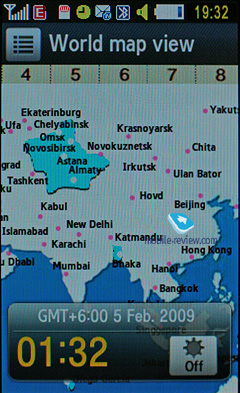
Calculator – It divides, multiplies, subtracts and adds and does several more things – quite enough for a mobile calculator.
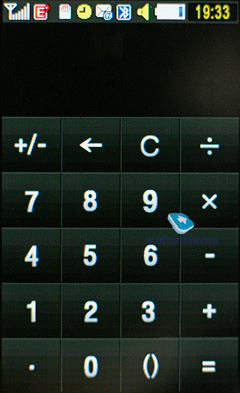
With the Converter you can operate with different units of measurements as well as with a number of currencies.
Back to the table of contents>>>
Applications
FM-radio. You can store up to 99 radio stations in the memory; the range of available frequencies is 87.5-108 MHz. Also, you can enjoy auto-tuning, but particular channels cannot have own names attached – they are always shown as frequencies. The radio implementation is fine, although it doesn’t pick up all stations equally well, but on balance, it is quite competent in comparison to other vendors’ offerings. The radio can be minimized.
RDS here displays only the station’s name in the general list, no advanced options available.
Voice recorder. You can record up to several hours of voice memos with the number of files being unlimited. Basically, limitations on recording duration are set by the user himself, though length of a single recording cannot exceed 1 hour. All the files are stored in a separate folder in the memory bank. The recorder performs well during lectures, conferences and presentations – I could even say that it is a partial substitute for a digital tape recorder.
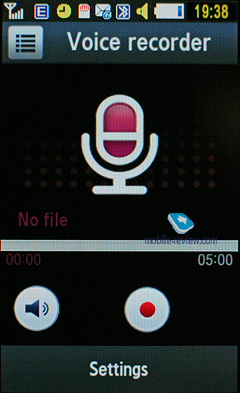
Countdown timer è Stopwatch have no bells and whistles.
Video editor. Allows editing video clips and overlay sound tracks. The most basic editor that makes its first appearance with the S8300.
RSS Reader. This is a stand-alone utility for RSS feeds. However, it would make more sense if the RSS Reader was bound up with the web-browser, but this is not the case with the S8300. This way, RSS links are not picked up by the browser, or sent directly to the application. You will need to manually submit a channel address in this app to subscribe, or enter a web address and let the application try to find an RSS channel on it.
While uploading your news feed, the S8300 can upload text, as well as video and audio files, and it is up to you to set the size limit (by default – 5 Mb per file). Regrettably, there no scheduled feed updates are available, thus you will need to refresh the feed manually every time you need hot news.
Bluetooth. As far as this app’s outfit goes, it has definitely been reworked thoroughly in the S8300 – now you can view the device map (like in some wireless managers on desktops) or opt to browser the standard version of device list. In terms of Bluetooth, the S8300 is a full-spec solution that won't let you down.
Games. The S8300 can multitask with Java applications, meaning that you can fire up a couple of programs, minimize them and bring them back to the top whenever you please. The games pool may vary by market; our unit features a full version of Checkers Deluxe and demos of BrainChallenge, DiamondTwistter, Millionaire 3 and PyramidBloxx.
Browser – read our lowdown on the browser below, in the section titled “Google”.
Share Pix – this utility will soon become a part of the default feature pack in many Samsung-branded phones. It allows setting up an account with one of image-sharing services, so as to make the phone tag and send all your images there without your help. However, when there is no WiFi network to tap into, the S8300 will use your carrier’s data connection, which will result in quite hefty bills should you leave this feature enabled.
Google. This menu features Google search, Gmail and Google Maps applications. Let’s start with the latter – there are no bells and whistles in the S8300’s version of these maps, however its 3.2-inch diagonal does make scrolling through them a much more gratifying experience. On top of that you can jump between satellite and street views, although the satellite images seemed somewhat rough to me, compared to other phones with this feature onboard. But probably it’s more due to the fact that the S8300 boasts a sizable diagonal, but lacks in the way of resolution. The phone pinpointed our location via cellular networks without any problems, so all in all, we have no gripes with this department.
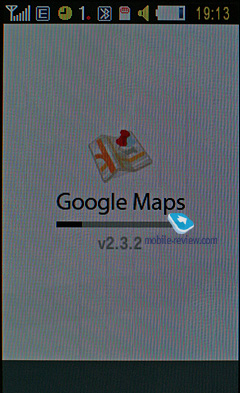 |
 |
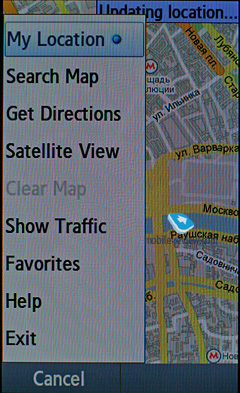 |
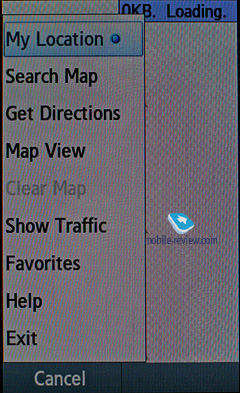 |
The phone comes preinstalled with NetFront 3.5 (WAP-browser ver. 2.0), sporting an improved page rendering algorithm that makes the whole process even smoother and faster. On the downside, unlike its Windows Mobile edition, this browser doesn’t have such a wealth of extra options and abilities.
Apart from JavaScript support, fonts scaling (three types), Smart-Fit (single-column view), full-screen mode (all controls are hidden), page caching, they have embedded a new feature – on-screen ‘mouse’ pointer. Much like Nokia’s S60-powered handsets and Opera Mini, you can view pages with a tiny navigation window displayed. The browser itself packs a lot of goods under the hood and will be appreciated by most users.
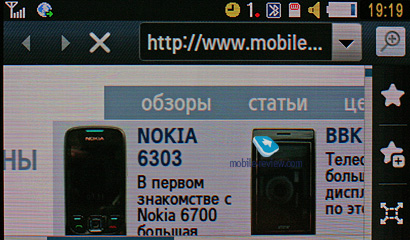
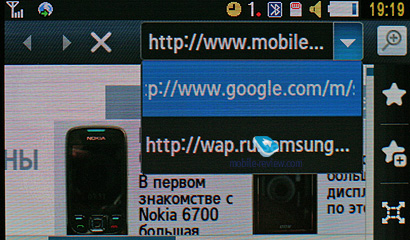
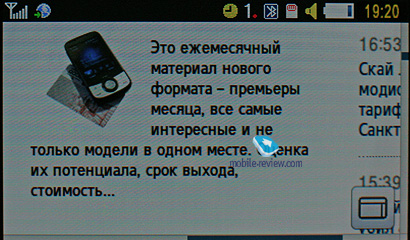
Back to the table of contents>>>
Alarm Clock
You can set up a number of alarm clocks in one touch or enable/disable the ones you have already created. Every alarm is fully customizable – you can pick any day you want and also use a custom tune.
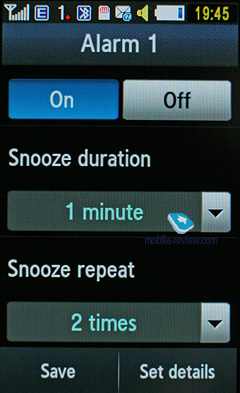
Back to the table of contents>>>
File Manager (My files)
That’s the place to search for all files such as music, pictures, video and sounds. Any uploaded file gets stored here. The disadvantage is that files sometimes are not displayed in the list immediately - in that case you will need to leave the menu and enter it again.
Files and folders can be viewed either as a list or thumbnails. You can mark any number of files. The handset supports Move, Copy and Delete operations, as well as various types of sorting (by type, name or size).

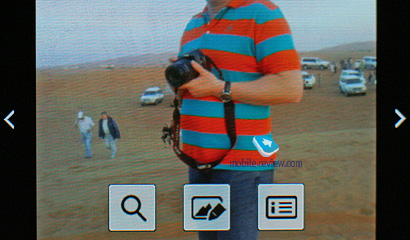
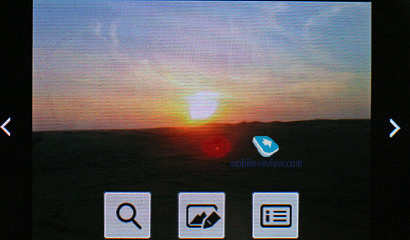
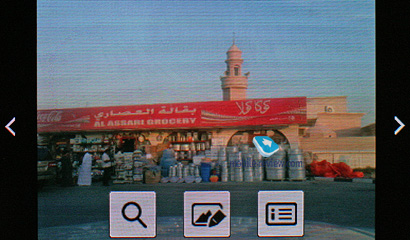
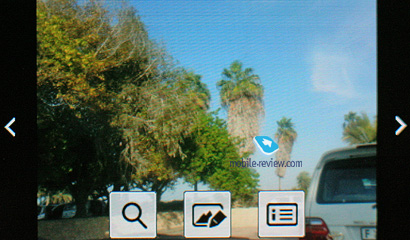
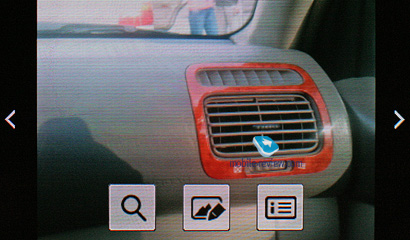
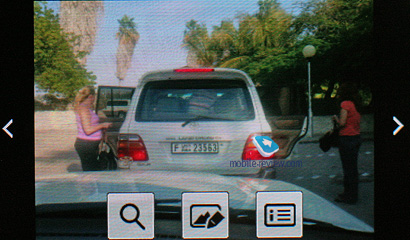
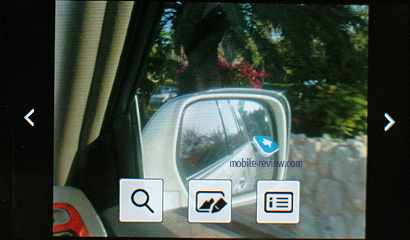

Back to the table of contents>>>
Settings
Traditionally this item boasts a standard set of options inside like password protection of selected sections. No special or quaint settings are available with the S8300. It only comes with an assortment of wallpapers and the ability to swap them randomly. The S8300 comes preloaded with profiles enabling the user to change the settings momentarily.
The font size, as well as its color and style are also adjustable.
The user can also modify vibration power for the VibeZ.
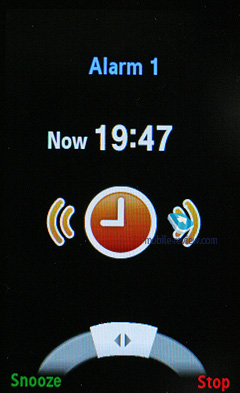
Mobile Tracker – submit a phone number, where notifications will be sent to in case SIM-card was changed - that message will contain number of the SIM-card being used with the handset. This section is protected with password, so that no one other than you or someone else who knows the password could disable the Tracker. Should your device have the SIM-card switched once, the specified number will receive one message instantly, and one more each time a new card is plugged in. A fetching feature which can prove to be of much help in case the handset is lost or stolen.
Back to the table of contents>>>
MP3-Player
The S8300 comes with is a typical latest-gen Samsung player. The integrated mp3 player, supports random, sequential and cyclic playback. Mp3 files can be uploaded onto the handset both directly over Bluetooth and through the sync application or Windows Media Player. There are no limitations on tags and names of music files. Bitrates are not something that really matters either – the handset easily deals with all available formats and supports WMA, AAC, eAAC, eAAC+.
The title of the currently played back track is displayed as well as the number of the remaining tracks. There is an equalizer is embedded in the S8300, but no way to tune it. Your tracks can be played through the stereo headset as well as the speakerphone. The volume bar has 14 scales on it. And of course the user can make up their own playlists. The player can work in minimized mode – in this case the display will show current track title and music controls, which is a good thing.
The player boasts the following filters: all tracks, recently played, most popular, artists, albums, genres and composers. Filters may be edited in the Settings menu (so that they’ll take account of some particular options). The S8300 also sports Album Arts support.
Speaking of new options, the player has obtained the rating system, enabling you to award any track with one to five stars. The maker has driven the integration with Windows Media Player as deep as it has never been before; actually, this manager also sports the rating system.
The bundled headset has a socket for plugging in custom earphones and ensures pretty good sound quality overall. Generally speaking, as a music-minded solution, the S8300 comes close to Sony Ericsson’s Walkman range, especially as far as the first generation is concerned. While at the standby screen, if you have the music player minimized, you will see its controls and current track title right on the display.
While in the speakerphone mode, the S8300 was not the best performer we had seen – it played somewhat distorted sound and obviously lacked power, even though the sound didn’t feel muffled.
Find Music (formerly known as Music Recognition) – a mere alternative to Sony Ericsson’s Track ID service. The gist of this service is this: you record a short clip from some music track you fancy and then the phone finds you its title and artist.
Back to the table of contents>>>
Watching video with the S8300
Some words about how the S8300 fares on the video front – thankfully, its widescreen gives it all it takes for a decent experience. The phone supports mpeg4, H.263, H.264, DivX, which allows you to drag and drop movies onto the memory card. In fact, maximum file size is unlimited, at least in our tests we used 600-700 Mb movies and experienced no hardships with them.
But the biggest letdown here is also one of the best things about the S8300 – its display. Sounds awkward, right? However, if your video is 240x320 pixels big, it won’t occupy the entire display, since the handset can’t fit the picture into the screen size, leaving black stripes on all sides. Where the Apple Touch excels, the S8300 simply can’t make a movie look eye-candy. You can also opt for bigger video resolutions, but at the cost of having occasional freeze-ups and blockiness on the screen. All in all, we felt pretty content with the S8300’s 240x400 display resolution as far as videos are concerned. Another thing going for it is that you won’t have to convert movies before uploading them onto the phone.
Back to the table of contents>>>
Picsel Viewer
Putting it short, Picsel Viewer is an application that opens MS Office files (for instance, MS Word, Excel, PowerPoint), Adobe Acrobat (PDF), picture and video formats on the phone. The attraction of this technology is its speed, when a 20 MB PDF file takes a couple of seconds to open, then you can quickly page through it, zoom in/out and rotate pages. No editing abilities here, only viewing is available with the S8300, but that is pretty much enough already, especially considering there is no need in extra conversions.
Back to the table of contents>>>
Impressions
We were content with the S8300’s reception quality, although it wasn’t much different from other phones in this class. The ring tones volume was pretty average, and we even missed some calls when the phone was stuffed in a bag. The vibro alert was nothing to shout about either, as it hadn’t changed at all, compared the PIXON. The fact that there are two microphones housed on the S8300 makes your voice quality quite decent even when making a call on a busy street.
Among all other things, the phone offers fast contact search, Fake Call and some other welcome features.
Positioned as a state-of-the-art phone, the S8300 fits the bill perfectly – it comes packaged with an 8 MP camera, pretty decent video recording department, a touch-sensitive screen and a hardware numberpad, bundled GPS (used in Google Maps, although there are no stand-alone applications for these purposes yet, probably we’ll see some Java-based apps or Mobile Navigator down the line). But to be honest, I don’t believe the S8300’s target audience will be able to find a good use for its GPS features.
With its release slotted for April, at 400-450 Euro the S8300 won’t face any direct competition. Even though it’s not a mass-market solution, it caters for the needs and tastes of its target niche extremely well. It’ll have a cheaper counterpart that will appeal to the broader audience and will become a decent, if not ideal, choice for many. We’ll publish a comprehensive review of this mysterious phone on its release day, February 16th.
On balance, I’d like to note that the S8300 is a likable phone that will definitely get its own share of attention. On the downside, though, its plastic could have been better and the spring loaded mechanism isn’t as good as you’d expect. But at the same time, it boasts one of the market’s finest displays, a wealth of extra feats, and all this – in a very compact package. In a way, the S8300 takes the idea of the M8800 PIXON one step further, although they have omitted all features that had something to do with enhanced data input there (handwriting recognition, on-screen QWERTY-keyboard and LivePix). And given the difference between their price tags (provided that you don’t need an imaging-savvy solution), the S8300 Ultra Touch looks like a good way to go.
Related links:
Back to the table of contents >>>
Eldar Murtazin (eldar@mobile-review.com)
Translated by Oleg Kononosov (oleg.kononosov@mobile-review.com)
Published — 09 February 2009
Have something to add?! Write us... eldar@mobile-review.com
News:
[ 31-07 16:21 ]Sir Jony Ive: Apple Isn't In It For The Money
[ 31-07 13:34 ]Video: Nokia Designer Interviews
[ 31-07 13:10 ]RIM To Layoff 3,000 More Employees
[ 30-07 20:59 ]Video: iPhone 5 Housing Shown Off
[ 30-07 19:12 ]Android Fortunes Decline In U.S.
[ 25-07 16:18 ]Why Apple Is Suing Samsung?
[ 25-07 15:53 ]A Few Choice Quotes About Apple ... By Samsung
[ 23-07 20:25 ]Russian iOS Hacker Calls It A Day
[ 23-07 17:40 ]Video: It's Still Not Out, But Galaxy Note 10.1 Gets An Ad
[ 19-07 19:10 ]Another Loss For Nokia: $1 Billion Down In Q2
[ 19-07 17:22 ]British Judge Orders Apple To Run Ads Saying Samsung Did Not Copy Them
[ 19-07 16:57 ]iPhone 5 To Feature Nano-SIM Cards
[ 18-07 14:20 ]What The iPad Could Have Looked Like ...
[ 18-07 13:25 ]App Store Hack Is Still Going Strong Despite Apple's Best Efforts
[ 13-07 12:34 ]Infographic: The (Hypothetical) Sale Of RIM
[ 13-07 11:10 ]Video: iPhone Hacker Makes In-App Purchases Free
[ 12-07 19:50 ]iPhone 5 Images Leak Again
[ 12-07 17:51 ]Android Takes 50%+ Of U.S. And Europe
[ 11-07 16:02 ]Apple Involved In 60% Of Patent Suits
[ 11-07 13:14 ]Video: Kindle Fire Gets A Jelly Bean
Subscribe
|
© Mobile-review.com, 2002-2012. All rights reserved.
|
